#Liminal Configuration :: Main
Explore tagged Tumblr posts
Text

Liminal Configuration :: Main/DBD-verse for Riley McKendry of Hellraiser (2022)
Finally, after all the pain, turmoil, and sacrificing... it was done. Riley had been through hell and back, and it was time to try and move on with her life. The words of the priestess echo in her mind "To live with what you've done... You have chosen the lament configuration."
She set the box down, walking away before the configuration begins to shift. Turning quickly, the young woman notices something... different. No blade, no blood, only a thick, black mist pouring from the contraption. "What the hell?"
Before she can react further, tendrils spring out from the box, one piercing her leg and yanking her foot out from under her. Any semblance of breath is knocked out of her with such a force, it forces an audible groan from her chest. The tendrils continue to pull her towards the box as she struggles, the hell priestess only a few meters from her, a smile sprawled across her face.
Was this her doing? Did she trick Riley? She wanted to think so, but the demonic being did nothing to intensify the pain, only mocking her fear until she notices her form begin to change, a black cloak growing over the exposed flesh. Voices overlap, the voice of her first form, and a more masculine one, matching the shifting features. Riley's eyes widen in fear as the fog begins to fully engulf her, "The box. You opened it..."
"It came!"
#dead by daylight#dbd rp#dbd-verse#breakcut 6/Riley#riley mckendry#hellraiser#hellraiser2022#Liminal Configuration :: Main
2 notes
·
View notes
Text
Riley looks to the other, the look in her eyes both tired and full of dread. She hasn't known sleep for a long while, even before her time in the fog. The configuration, the brutality of the cenobites, the many people whose deaths she's responsible for; all too fresh on her mind, no matter how long ago the events seem to have happened,
"I uh-..." she pauses for a moment, does she lie to not make herself feel so powerless, or does she relay the truth, and accept the grim reality that has shaped her into a survivor. "I don't... really sleep."

Even when she pumps herself full of the prescription painkillers or back-alley depressants she had brought with her into the eldritch realm of the entity, she only feels lethargic, even catatonic at times. But... never is she truly able to rest, her mind constantly flooded with pain and torment both before and after the monstrosity's intervention.
"With everything that's happened, would you say that's normal?" The young woman tucks her knees into her chest as a single tear rolls down her cheek, her expression still hollow. "Or am I actually starting to go crazy?"

@breakcut : "Do you ever feel like you can't escape it, that feeling of dread?" Riley McKendry ᠂ ⚘ ˚
The campfire licks shadows across the contours of the two women’s faces, the flickers bringing a much needed warmth. Reaching fingers of small hands do their periodic retreat, folding atop knees locked together under the skirt of her black work dress. Her attire suits her client relations job better than huddling around a campfire in the foggy woods, but at least something feels familiar.

Riley’s voice turns the older woman’s chin; a consoling frown and ever-thoughtful gaze follow. Dread. An unfortunate word for what it is. A sigh falls, a precursor to agreeing with her assessment. The tension lost in her drooping shoulder betrays the exhaustion of constantly strained emotions, emotions they all must feel to feed the Entity that holds them hostage ( at least that is what she is told ).
“It sits heavy on the chest. The waiting. Always waiting, and believing it’s never for something good.” The outlines of a British accent are present in her quieted speech, lightened by her French heritage; one of the few Europeans among them.
“How are you sleeping?” She speaks with concern; sleep is perhaps the only escape from it all.
#breakcut#breakcut 6/riley#riley mckendry#Liminal Configuration :: Main#prvtocol#(Ofc! I'm already vibing with this thread <3)
5 notes
·
View notes
Text
More Roddenberry Archive musings...
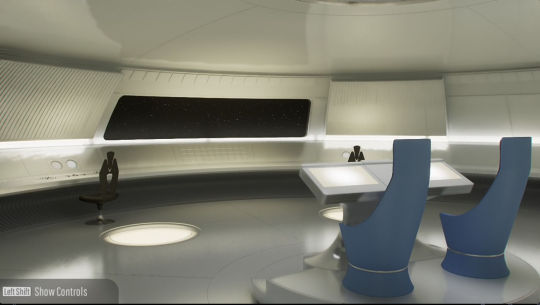
This is supposedly the launch configuration of the Prime universe U.S.S. Enterprise NCC-1701's main bridge. It's based on the first piece of concept art for the TOS set, and is one of several weird not-quite-canon things the Roddenberry Archive has decided to consider canonical. 2 command chairs and the whole centre console and chairs spins to face the very minimalist 60's scifi perimeter consoles or viewscreen. Try to imagine Captain April and first officer Chris Pike on this bridge, it's weird.

Behold! The top of the Jeffries Tube.
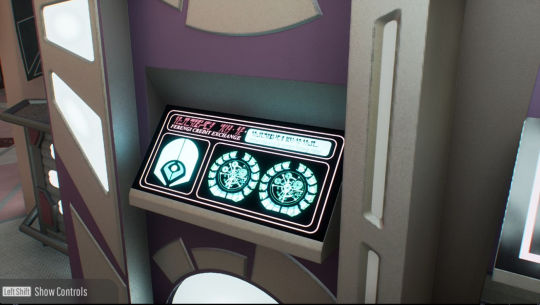
FERENGI ATM MACHINE ON THE PROMENADE!!!!
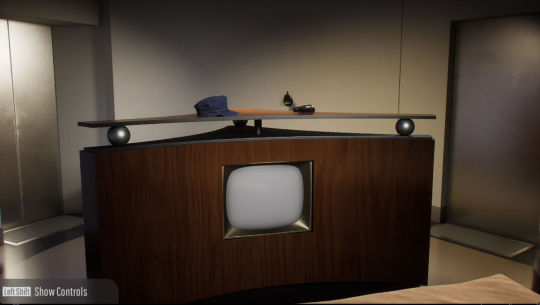
The view from OG Captain Pike's bed, featuring his awesome TV, his laser gun and his Starfleet hat. We wouldn't get hats back in Trek for 50 years.

This is inside the Ringship Enterprise XCV-330, circa 2100. The Ringship in canon was seen only in picture form or a desktop model, we never saw inside. The ship was actually designed for a non-Trek Roddenberry scifi show called Starship which never came to be, and there was actually concept art made for the interior which the RA people decided to import to Trek too. Predating the transporter, here is the Metafier.
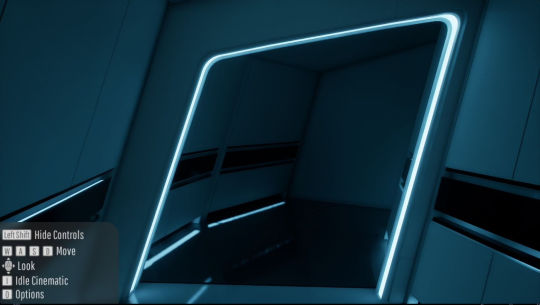
Discovery Season 2's U.S.S. Enterprise has a cool corridor running around it. Walk around it and... it goes nowhere😂 the Archive tries to balance the reality of everything being a television show with the fantasy of a 100% accurate in-universe museum, it'll give sets ceilings to make them into a believable spaceship but doesn't want to go nuts inventing too much of it's own stuff and that sometimes leads to weird stuff like this dead end
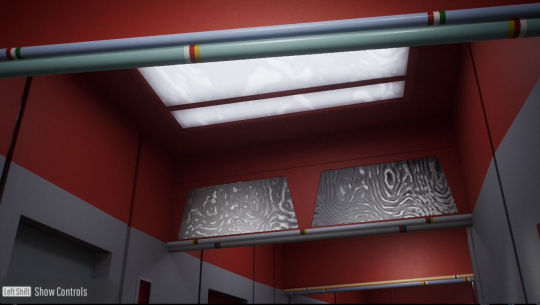
Speaking of ceilings, here's the ceiling and lights of the classic TOS Enterprise's corridors. I think they did a decent job keeping to the TOS aesthetic. The sets TOS was filmed on didn't have ceilings at all.
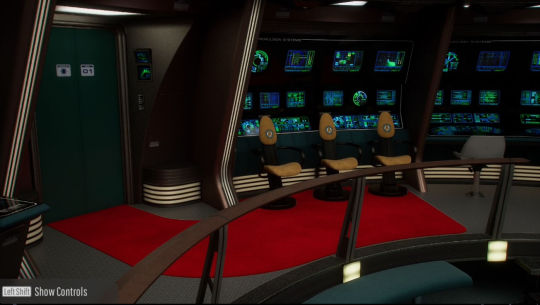
The Enterprise-B actually had a red carpet for special guests Kirk, Scotty and Chekov
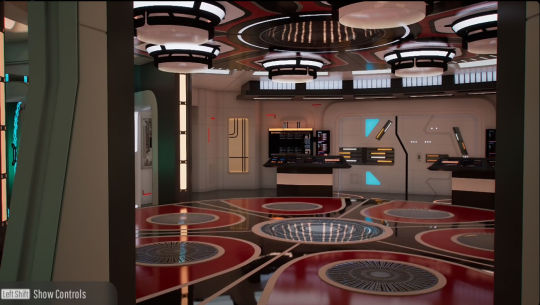
Strange New Worlds has the coolest transporter room of all. Just look at it😍

The TNG Enterprise battle bridge has it's own ready room! And it's super tiny, ultra cramped and Picard probably never used it because there's no replicator in there and thus no access to tea.
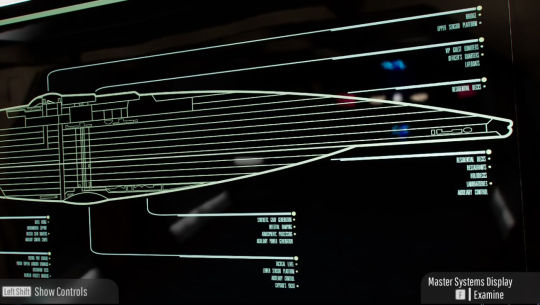
The 1st version of TNG engineering's big Master Systems Display as seen in "Encounter at Farpoint". Ten Forward wouldn't be a thing until season 2, and you can see here an earlier deck layout and the original concept for the saucer rim, a corridor walkway with windows above and below. You'll also note Ten Forward would actually be on deck 11 had they not changed the diagram by then.
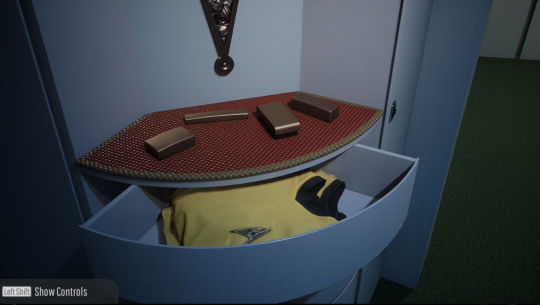
Kirk's quarters on the TOS Enterprise has dresser drawers full of uniforms for when his gets torn
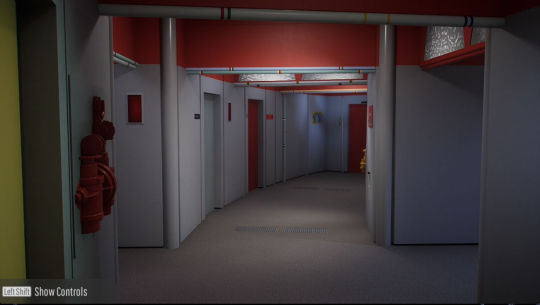
Walking around the Roddenberry Archive ships is eerie as hell. You're the only one on board, exploring corridors and poking your head into rooms. These starships are liminal spaces. This for me adds to the atmosphere greatly.
Here's the link (enjoy before it vanishes again!):
Roddenberry.x.io
Here's my original post about the Roddenberry Archive:
Also a clarification, I was wrong when I said it won't be in VR. There is one VR setup it was designed for - the $3,000 Apple Vision Pro. More details here, although it appears to only show a 2D window rather than be fully immersive 3D, possibly confirming what I was told previously that no current 3D setup is capable of doing a true VR experience:
#star trek#star trek the original series#tng#starship design#behind the scenes#roddenberry archive#deep dive#ringship enterprise#the next generation#strange new worlds#apple vision pro#uss enterprise#enterprise
207 notes
·
View notes
Text
the purgatory papers | introduction: part two

"enter.. we have much to discuss."
minors dni. ageless blogs dni. blank blogs dni. you'll be blocked. <- part one | main masterlist | part three -> character(s): gn!reader, kim hongjoong, choi san, park seonghwa, kang yeosang; (minatozaki sana, myoui mina;) tags: explicit language, light banter, slight hostility, alcohol, references to drinking alcohol to cope word count: 5.1k summary: with only a vague idea of what lies ahead of you, you take a trip to both hell and heaven to speak with the people involved. in doing so, you start to get a glimpse of just what exactly you're dealing with.. a/n: i initially intended to this just be one long introductory chapter, but i'm actually gonna split this into three parts because this second part ended up way longer than i thought it was going to;😭 i hope you enjoy!

The road to hell is paved with good intentions.
You give the mortal world exceedingly less credit than the folks in Heaven would, but it’s not lost on you that the configuration of Heaven, Hell and purgatory are exactly how they’ve envisioned it for thousands of years. For the nth time it makes you chuckle as you descend the staircase into the cavernous pit, recalling how you once joked with Yunho that the mortal world is basically the living room, and that they would sometimes refer to Heaven and Hell as upstairs and downstairs respectively.
One thing that is slightly off is that purgatory still, in part, exists as a liminal space above the sphere as well as below it. The area in which you live means you often refer to it as downstairs.
As for Hell, that’s the basement.
And much like the mortals, no trip to the basement is a fun one.
The temperature is known to increase, but you yourself don’t feel it much, bar the odd sweat beads that form across your hairline. As you approach the door to Hell, the air does become noticeably stuffy, and you wonder if they upped the fire resources in the last century and why exactly they felt the need to bask in more heat than necessary.
Then you recall how the temperature is governed by the overseer’s temper - hence temperature - and it all starts to make sense.
Old Horns’ feathers have been ruffled in greatly unfortunate ways.
There’s a single security guard standing by the door to Hell, someone you’ve strangely become good friends with since you first met two centuries ago. Her eyes light up at your arrival, and her smile invites you to smile back. However reluctant you felt to take on this job, it’s always nice to see her again.
“Well, well, look who it is!” she teases. Embers of orange dance around the curls of her auburn hair, her black, backless dress trailing the floor. “Never one to stay a stranger, hey?” She smirks, knowing full well why you’re here, but opting not to say the quiet part out loud.
“Business as usual,” you nod, then exhale deeply, “for the last time.”
Sana’s face falls instantly. You didn’t think such an expression would sting so much. “Oh. So, that means you won’t be paying any more visits to Hell.” She says it so matter-of-factly, as if she already understands how this is going to work, but there’s still a tinge of sadness in her voice. It makes you feel genuinely awful.
“Well-” You trip over your words in an attempt to placate her. “Not necessarily!” you perk up. “I can still pay you a visit!” you say. Sana grins again, so bright and effervescent. It actually brings you joy to cheer her up about this. A strong heart lies dormant in your dwelling soul after all. “And besides, no more business means I’ll have more free time.”
“We can do the stairwell picnic we talked about!”
Ah, the stairwell picnic. Meet halfway along the staircase and eat snacks while waxing philosophical about the mortal world.
You smile. “Yeah, I’d like that.”
Sana claps her hands excitedly. “Excellent! Well- ahem- enough chit-chat.” She opens the door to Hell. “Welcome to the fire!”
“Speaking of that,” you mutter into her ear as you walk past, “have you noticed that it’s warmer down here? If I’ve noticed, then you’ve surely noticed.”
Sana coughs weakly, trying to ignore what is so clearly a bothersome elephant. “Well.. Um, yeah, to be honest, it’s not really my place to make a comment,” she whispers in response. “But.. it is.” She seriously lowers her tone for that last part. You swallow the lump in your throat and nod. Sana’s smile then returns and she almost nudges you into Hell. “Have fun!”
The door shuts behind you, and the noise is thunderous. Most of the residents here turn to see you, and they hone their eyes at your presence.
You’re not their favourite member of the band.
Without a second to waste, you depart for the corridor to Hongjoong’s office.
Not a single eye leaves you as you speed down the narrow halls of the overseer’s domain. Many of them begin to chat among themselves; you know they’re talking about you.
The two guards outside Hongjoong’s door straighten their backs as you draw near. One holds up their hand and speaks in a low, harsh voice. “Excuse me, this area is out of bounds.”
“I have express permission from Hongjoong himself to speak with him.”
The guards exchange looks. They turn back to you, and the other speaks, his voice rougher than the first. “Is that so? Do you have any identification to prove this?”
“I have this red card,” you announce, pulling the item out of your inside jacket pocket. You hand it to the first guard, and they both inspect it diligently, before bursting into laughter.
“Nice try, but this is, for lack of a better word, bullshit,” chides the second guard. He evaporates the card with a single toss in the air.
You groan internally and try again, “Listen, I know this is completely unheard of, but Kim Hongjoong has specifically asked for me to speak with him on a very important matter.”
The first guard stutters over his laughter, “What? You’re joking, right? The High Devil doesn’t speak to anyone unless he has given the word.”
“Yeah, if he wanted to speak to you, he would’ve informed us,” says the second guard.
“If that is the elder of purgatory, let them in.”
The sound resonates through the door, startling the three of you.
“Uh-”
“Um-”
“But- But Your Highness-”
“Did they present you with a red card?”
The guards eye one another. You lift a brow at them as if to say, see, what did I tell you?
In an instant, the second guard restores the item to its former glory and hands it over to you with a mouthed apology. You take it with a shameful shake of the head and fold your arms.
“Um, yes, Your Highness, they did.”
A beat passes, and the door opens, seemingly by itself. The two men part in the centre and stare straight ahead, assuming a stoic position despite the dread coursing through their veins.
“Enter, N. We have much to discuss.”
You take a deep breath in and let go. With your shoulders pushed back, you pass by the guards and enter the office of Hell’s overseer.
The second you’re through the door, it slams shut behind you, making you jump. You place a hand on your chest - a habit you picked up from the many times you’ve manifested, mortals seemed to do that when something surprised them - and exhale through your nose.
Ahead of you, the High Devil paces back and forth in front of his desk.
You take a moment to have a good look at the place. It’s the first time you’ve set foot in this room. The ceilings are so high you can’t see where they end, but the room itself is surprisingly small for such a figure like Old Horns.
The walls are draped with burgundy curtains and there are candles everywhere. To most people, this room would be unbelievably dark, but you are able to see Hongjoong very clearly. His desk almost takes up the total width of the room and seems to be carved from mahogany or oak.
You clear your throat quietly and remind yourself that you’re not here to admire his decor.
Hongjoong stops when he notices you. “Ah.” He quickly disappears in a cloud of smoke beneath the desk then reappears on the other side, already sitting in his chair, a motion that doesn’t phase you. “Take a seat.”
There’s a passive sense of magnitude inside you; this is the first time you’ve ever met Hongjoong, the first time you’ve ever stepped into his office, something strictly forbidden unless he specifically requests it. Over the course of the three millennia that you’ve spent in purgatory, that occasion is so rare that you notice three distinct plaques affixed to the wall behind him denoting these moments as some sort of achievements.
You assume this meeting will add a fourth to that collection.
Eventually, you take a seat opposite and slowly descend into the chair. Perhaps that feeling isn’t so passive after all.
Everything that you’ve understood about Hongjoong over the centuries is now taking full effect right in front of you. He doesn’t make eye contact, doesn’t seem particularly pleased with social interaction, and the embers don’t so much dance around his hair as they do shift erratically around his entire form.
Neither of you speak for a time. What do you say? Do you even say anything at all? Yunho hadn’t exactly debriefed you on the appropriate etiquette for talking to the High Devil.
Uncomfortable silence spreads through the whole room until eventually, Hongjoong shifts his gaze to the side and speaks. “I am sure you understand why I have asked you to come here.”
Understand is probably not the word you’d go for, but for the purposes of getting this over and done with you agree. “Yes.”
“Good. Because as you can probably tell, I am up to my fu- God- .. neck in it.”
You blink a couple of times. Old Horns not being partial to the odd cuss? Colour yourself shocked.
You spare him any quippy remarks, you’ve never met the man before, after all, and instead simply say, “..Yes.”
“This feud, this-” He tries stalling his anger by clenching a fist and resting his lips against it. “I’ve been Hell’s overseer for thousands of years. I’ve seen things come out of this amorphous realm that I couldn’t begin to describe to you. But this?”
“Somehow worse than that?” you stutter, nervous even still of stepping a single syllable out of line.
He swallows. He breathes out. He looks up at you.
Kim Hongjoong looks up at you.
Your entire being turns to stone as he maintains eye contact with you.
“It’s a level of spite and vitriol that I can’t possibly comprehend.”
Your resolve shatters. This all makes sense. Of course Hongjoong has seen shit that no one else has ever seen, he’s the goddamn leader of Hell.
But this.. this is something he can’t comprehend.
And it’s your job to cipher an explanation. It’s your job to help Hongjoong understand.
He’s typically never cared for the feuds. Anything that goes on between the residents of Heaven and Hell has nothing to do with him.
But now he is directly involved.
And for whatever reason, this has stoked a fire so strong it’s caused him to increase the temperature.
You brave a question that’s been on the tip of your tongue for the last minute or so. “What is it about this animosity that you cannot comprehend?”
Hongjoong leans forward, not breaking eye contact with you for a second.
“Why the elder in question didn’t take things up with Seonghwa while he had the chance.”
Seonghwa. The de-facto leader of Heaven.
Why for the love of all that is good is Seonghwa involved?
You hold back on making a comment but your face says it all. Hongjoong scoffs, “Yeah. I know. Trust me, getting in touch with him was not on my to-do list.”
“You- You got in touch with him?” you hesitate to say. Hongjoong nods solemnly.
Why didn’t Yunho mention this? Did he even know?
You chew the insides of your bottom lip and ponder for a while; Yunho and Seonghwa have never met.
But if this is as big and as serious as Yunho said it is, as Hongjoong is currently claiming it is, to the point Seonghwa of all people is in the know, then why were you not informed?
Why didn’t Seonghwa tell you?
You and Seonghwa had been friends for quite a while, ever since you were merely a dweller. He had not long become the leader of Heaven, though Heaven never really had a leader. It was simply a placeholder title, the illusion of someone with authority beyond the pearly gates, but Seonghwa doesn’t rule in the way Hongjoong does. He mainly acts as a figure of guidance, a literal guardian angel as the other residents had joked. Heaven did have space for a sense of humour.
Given your history, it feels like something Seonghwa would have relayed to you during your monthly catch-ups. Heck, your last catch-up was only a fortnight ago, so is this an incredibly recent thing? Could he not have sent a message, was the information too confidential to risk a telegram?
There’s a flood of questions drowning every cell in your brain to the point it almost leaks out of your ears. You grip the rests of the chair until your fingers hurt, which to your surprise, concerns Hongjoong.
“Um, N? Is there something on your mind?”
You gaze up at him, foregoing any distant regret at the act. “Seonghwa never told me.” Hongjoong sits back in his chair. “I feel like- y’know you’re probably not aware of this, but, we’ve been friends for a while-”
“I am aware,” he reveals, “Seonghwa actually conceded that I ask after you in order to sort this situation out.”
You let go of the arm rests and place both hands on the desk. It’s cold to the touch, remarkable for such a sweltering space. “Y’know, not to make this about me, I just.. It’s weird, y’know, unless this happened in the last week, then I guess that makes sense, but-” Hongjoong’s words finally register. “He- He said what?”
Hongjoong sighs. “Seonghwa conceded that we ask after you. Full disclosure, this has been going on for a while, but it only really came to a head in the last week or so. He confided in me that he has been going back and forth in his brain over whether or not to send you a message himself, but that changed when I knocked on his door.”
Sparks are firing off every inch of your body. The room is suddenly much hotter, and your nerves are somehow flying through the very tall roof of this office.
“I- Fucking hell-”
A hand flies to your mouth. Lower-case hell, and yet, it still stings on your tongue when you remember where you are.
Hongjoong shrugs it off, even managing to crack a smile. “Honestly, N, that does not phase me one bit.”
Your hand falls. “I- ahem- I’m sorry.”
“Worry not, N. I hear that sentiment all the time down here.”
The conversation has become calm out of nowhere. For a small moment, you forget yourself, but you immediately spring back when the embers return and Hongjoong’s eyes harden.
“Trust me, this situation is relentless on all fronts. I have an elder stewing in his own hatred and guilt, and there’s an angel upstairs he’s got it in for.”
“And you need me to scope this out?”
Hongjoong looks at you. “Yes. Please. If you would be the kindest.”
Taking a deep breath, you rest your forearms back on the desk. “Okay. Give me the details, and I’ll pay a visit to Heaven and talk to Seonghwa.”
“Good idea.” Hongjoong clicks his fingers once and a sheet of paper appears between his thumb and forefinger. “Here’s all the information you’ll need. I know that Yunho didn’t give you much, but that’s because I had all of it.”
You glance at the paperwork. At the very top, you see two names.
Choi San and Kang Yeosang
Choi San being the devil. Kang Yeosang being the angel.
Reading through the paperwork is an absolute trip. It’s all still so vague and yet you have your work cut out for you.
San - Elder. Four millennia. Mysterious past - possible connection to Heaven? Long history with Kang Yeosang. Seonghwa knows him of old, but the two never got along. San was never an angel, but has a history with Heaven. Yeosang - Divine. Two millennia. Harbouring a secret that no one in Heaven knows, not even Seonghwa. hates San with a burning passion. The facts - San and Yeosang have a long history. There are connections between the two of them via Heaven and Hell, but they have no connection to purgatory. Only they know why they feel the way they do, except Seonghwa has a theory that either one of them used to be residents of the other. The questions - Why didn’t San tell Seonghwa about this situation? What is the history that connects San to heaven, despite him never being an angel? Was Yeosang once a devil? Was San the reason he left Hell, or was Yeosang the reason San left Heaven? What do the other residents know of their history? Is there anything that San’s closest friend in Hell, Jung Wooyoung, can tell us about their past? Why has their feud caused such a terrible rift?
Your brows knit at a name you don’t recognise. “Jung Wooyoung?”
Hongjoong scoffs the meekest smile. “Ah, Wooyoung. The true definition of a daredevil. He has been here for two millennia, good friend of San. He likes to manifest to the mortal world a lot, so he doesn’t often spend time in Hell.”
You tilt your head. Interesting.
Hongjoong senses your gears turning and explains further, “I only added that question because something tells me he might know something. I mean, the two of them clicked almost immediately when they first met. Wooyoung had been there for a few centuries by that time. San was in a bit of a mortal world phase so he wasn’t around when Wooyoung first arrived.”
As Hongjoong speaks, you store all the necessary mental notes and remind yourself to jot them down in your notebook once you’re back.
“I see. Thank you for letting me know.”
Hongjoongs nods once, very politely, then shuffles the remaining papers in front of him. “So, with that, I believe that concludes our meeting. Do you have any questions?”
Yes, and no.
“I don’t think so,” you tell a half-truth. Or is it closer to a lie? You’re not sure.
“Well, if anything changes, send a telegram through Yunho and I will reply as promptly as possible.”
“But what if by that point I’ve manifested to the mortal world?”
Hongjoong hums, then strokes his chin. “Good point.” He then smirks a little. “In that case, do it the old-fashioned way.”
You make a face you can hardly believe you’re making in the presence of the High Devil, and he laughs, though it comes out as more of a heavy rumble. “Nobody has done that for hundreds of years.”
“Well then, perhaps you can start a new wave.”
You stand up, take the piece of paper, then fold it before putting it in your jacket pocket. “It has been quite the bizarre honour to speak with you, Your Highness.”
You can’t exactly say the meeting was amicable, but it certainly wasn’t hostile either.
Hongjoong regards you reverently. “And I you, N. Take care, and make yourself scarce.”
Exactly what Yunho had said. Not quite two peas in a pod, but close enough.
Upon leaving the office, you bypass the two guards with ease and make your way to the entrance.
That is until you are stopped by one of the devils.
“Excuse me, what were you doing speaking to the High Devil himself?”
You glance at the devil. His short, black hair is swept back off his forehead and stiff, as though held back in place with gel. You know of mortals styling their hair in various ways. Perhaps this is a look this devil picked up from one of his visits. “The meeting between us is strictly confidential, now please excuse me.”
You skirt around him and head for the door. He turns in place and yells after you, “Hey! We know why you’re here, don’t pretend like we don’t. We’re not fucking stupid, y’know.”
“San..” you hear another mutter.
San.
Shit, that’s San?
If you make your business known, he will know it’s him you’re getting the scoop on.
“You’re just here to get another article in your miserable paper. Haven’t you had enough of that?” he chides.
You swallow the lump in your throat and leave, not even sparing Sana a glance, regrettably so. Sana watches you ascend the stairs, and the door to Hell closes behind you.
Halfway up, you reach the doors of purgatory, your proverbial home, and take a few deep breaths.
Nothing has ever left you feeling so stilted. Residents of purgatory have no room for such strong emotions, and being an elder yourself, it’s astonishing that a split second confrontation with another elder has left you more winded than an entire meeting with Hell’s overseer.
His words turn somersaults in your mind as you continue your journey up to Heaven. All the while, you wonder if talking to Seonghwa will calm you down, you are friends after all, but then you remember his involvement in this feud.
And by the time you get to Heaven, the familiar face you’ve come to know as Mina, who much like Sana, acts as a security guard to the gates, is full of thunder in a way you have never witnessed before.
“Mina..” you inaudibly breathe out.
“N, good gracious, am I ever pleased to see you.” She approaches you and immediately wraps her arms around your shoulders, a gesture uncommon for her, and you awkwardly return the hug before she pulls back. She grabs your arms and looks you dead in the eyes, “N, there is no polite way for me to say this, but Seonghwa is beyond inconsolable.”
You sigh deeply and look askance. “Don’t worry, I have some idea.”
“I thought you might,” she replies, letting go of your arms. “You have the face of someone who’s called at Hell already and hasn’t had the best experience.”
“You would be shocked to understand why.” Mina flexes a brow. “My meeting with the High Devil went pretty smoothly, actually,” - Mina then lifts both brows in shock - “I know. It was what happened after that that caused this.” You gesture vaguely to yourself and Mina exhales sympathetically.
“Oh dear. Did someone make a pointed remark?”
“Only one half of the party involved, no big deal,” you shrug it off sardonically, and Mina’s head falls in her hands. “The silver lining is that I don’t think he recognised that what I’m helping out with concerns him, so I think I’ve bought myself some time.”
“Any time is better than none,” Mina concedes. “But it is also of the essence, specifically in regards to Seonghwa.”
You glance at her, “Do you know the full extent of what’s going on?”
“Goodness, no. Not my business, not my place to ask. But I just know it’s another disagreement, and this one is so bad it’s made him so upset to the point I’ve been dragged into calming him down.”
You reach for her hands, tucking them into your own. “You have my sincerest apologies, Mina. I’ll see what I can do.”
“Worry not, dear, it is out of your control. I just hope things clear up eventually.”
“So do I. Okay, let’s go find Mr. Sad Wings.”
Mina stifles a laugh with a shake of the head, then hesitantly opens the door to Heaven.
You create a shield over your eyes with your hand; how do you constantly forget how bright it is in Heaven?
From afar, you notice a swath of angels surrounding a boldly disgruntled figure, fanning his face with their own wings and replenishing his cup with a dark red liquid.
You stop in place and cock a brow. Trust Seonghwa to unleash his inner amateur dramatics.
Seonghwa then notices you, and within seconds tells every angel to flee his presence. “Ah! N! Precious N, my dearest friend, how pleased I am to see you, my goodness.”
“Seonghwa,” you bluntly reply, dissatisfied with the performance.
He notices this and places a hand on his chest, genuinely offended by your attitude. “N! Can you not see I am in the greatest distress?”
“I can see you’re donning your I wish I was on Broadway slacks again.”
Seonghwa instantly halts the act and glares at you. “Fine.” He stands up, sets the cup aside and walks towards you. “You’re here, finally.”
“Finally?” you utter, taken aback.
Exasperated, Seonghwa exhales deliberately. “Listen, N, I am truly sorry, but the past 48 hours have been an absolute nightmare.”
“I can see, I can tell, and I know. You don’t have to say anything to me I haven’t already heard from Old Horns.”
He blinks at you. “Wait, you mean to tell me you went there first?”
You shrug, “Thought I’d get it out of the way, and honestly I’m glad, he was the one that ended up telling me about your involvement in this mess.”
He reflexively closes his eyes with yet another frustrated sigh. “Do not get me started, I have not caught a break from this since all- of it started breaking loose.”
Folding your arms, you shift to the side. “So much so Hongjoong had to get in touch?”
Seonghwa’s eyes open and he stares at you. “He told you that too?”
“Of course he did, Seonghwa. Hongjoong filled me in on everything he felt I needed to know, including this..” You pat the left side of your jacket discreetly, alluding to the information within, and Seonghwa pushes his shoulders back nervously. “You know me, I’ve been quite successful at my job, and if it means managing to help both leaders of Heaven and Hell at once, I consider it a bonus.”
“Hey! I am not the leader, you know how I feel about that.”
“De-facto leader.”
“Not even that! I don’t like being associated with the term, it makes me feel like a deity.” He adjusts his outfit, closing in on himself more as he stares at the cloudiness that covers his feet.
“Well, how should I refer to you if not by your name?”
“As I always have since I became an elder: an elder.” Seonghwa looks about the place then back at you. “Everyone here calls me a leader, it’s unnerving.” He shivers in the place at the mere thought then exhales. “So, you have all the information you need, you know exactly what you’re dealing with, why exactly have you come to see me?” he asks.
“Oh, am I not allowed to see you anymore?” you tease lightheartedly. Seonghwa rolls his eyes at your comment and explains that it isn’t about that, but that maybe you wouldn’t want to loiter around considering the sincerity of the situation. You ponder this and concede his viewpoint, but then you remember the feelings laying in the far back of your mind and scratch the nape of your neck. Honesty is the best policy. “Well, to be frank, when Hongjoong told me that you were a part of this, I wondered why you hadn’t said anything to me.” Seonghwa listens, but looks at the floor almost shamefully. “I just.. It just seemed a bit weird, since we’ve known each other so long and we talk about basically everything.”
“I see where you’re coming from,” Seonghwa replies, eventually gazing up at you. “It was never my intention to withhold anything from you, there was no malicious foresight.” You didn’t think there was, but continue to listen anyway. “I suppose I didn’t say anything right away because I just knew this would result in something that you’d be asked to get the answers on in a professional manner.”
“So it didn’t feel right to confront me on a personal basis?”
“Exactly.”
You hum in understanding. “Makes sense.”
“Trust me, N, this is well beyond both mine and Hongjoong’s imagination. I reckon it was quite odd for Yunho to discover as well.”
This takes you aback. Seonghwa rarely, if ever, references your boss directly, much less so by name.
You bite your tongue and decide not to dwell on it. “Oh, trust me, he was as shocked as anything.”
Seonghwa nods knowingly. “Well, to be honest, that is all I really understand about the situation. Anything you could possibly glean from my knowledge is contained in that paperwork, I can guarantee it.” He indicates your jacket pocket then clasps a hand over the other wrist, settling it on his abdomen. “I wish you the best of luck on his endeavour, and for the good of all that is gracious, don’t cross any wires.”
You lift a brow. “Meaning?”
Seonghwa goes to turn his back in a very defensive fashion. “Once you start divulging, it will all make sense.” Without another word, he walks away from you, lifting his cup and taking a sip of the wine within.
You feel the most bizarre interaction you’ve ever had with your closest friend has come to a rather unnatural conclusion, and instead of saying goodbye, you simply bow your head and turn to exit Heaven.
Before you can reach the gates, however, Seonghwa has another message for you.
“Be careful on the way down. It’s risky business.”
You stop in place. The same thing he always says before you go on a new adventure.
A smile cracks through the plaintive neutrality of your expression, and you leave, knowing that Seonghwa is smiling too, and that no matter what, you will always have each other’s best interests at heart.
×-×
Seonghwa moves through the courtyard of Heaven and takes a seat on one of the grey, velvet chairs in the corner of the room.
In the corner of his eye, he notices a certain other angel approaching.
The angel takes a seat beside him. Seonghwa lowers his cup and rests it in his lap.
“Was that N, perchance?” wonders the angel.
Seonghwa knows the residents of Heaven and Hell are aware of N, but they’re not always aware of what N is up to. Seonghwa peers over the cup, not sparing him a glance. “Yes, it was.”
The angel looks askance towards the floor. “Must be up to something exciting.”
The words get clogged in Seonghwa’s throat, so much so he cannot take another sip of his wine. He keeps himself occupied by running his finger around the rim, hoping to goodness that the angel doesn’t prod him for any more answers.
The divine looks back at him. “More wine, dear leader?”
Seonghwa almost coughs up the lump in his throat and shakes his head. “No, thank you, Yeosang.”
Yeosang nods his head and leaves him be. A cold shadow follows the divine as Seonghwa watches him go.
Yeosang heads to the other side of the room and sits beneath a silver canopy. Crossing one leg over another, he quietly observes the other angels.
An unsettling thought creeps into the back of his mind. He needs his own drink.

taglist: @bikerjongho × @lavishloving
× silverdune (ave). do not repost. ×
#ateez scenarios#ateez imagines#san scenarios#san imagines#yeosang scenarios#yeosang imagines#ateez x reader#san x reader#yeosang x reader#ateez au#ateez fanfic#words.(ave)#fic: the purgatory papers
11 notes
·
View notes
Text
HELLRAISER TIER LIST
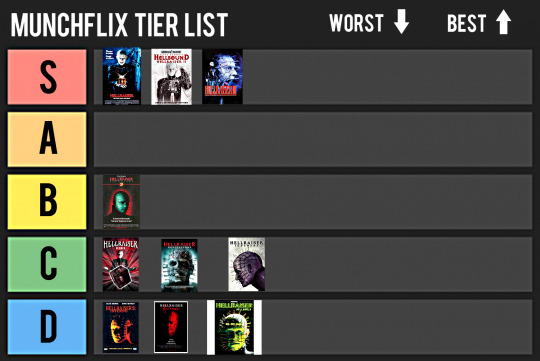
Munch: This is, I say regrettably, my favorite franchise. That being said, my version of my favorite franchise ends abruptly at the fourth installment.
Biscuits: This your boy??? This your man???

M: Yeah...I know.
B: This one took a while because...we had to watch the movies. I wish we hadn't. I wish I had not watched the movies. I will never forgive me for making me watch ALL OF THESE FUCKING MOVIES. Each one took years off my life span. I'd already seen the first four but...
M: They're bad. They're direct to video bad. They're 3 dollar bin at Walmart bad and I still want my money back.
B: They'd be walk out of the theatre movie bad but you can't because most of them weren't in theaters. They're turn it off and watch some porn bad.
M: That being said...I am a huge Hellraiser fan. I love the lore, I love the mythology. I own the comics, I own the movies, I love Doug Bradley so much. Pinhead is my absolute favorite boi. But alas....we must review this shit. So here we go. PART THE ONE. A woman discovers the newly resurrected, partially formed, body of her brother-in-law. She starts killing for him to revitalize his body so he can escape the demonic beings that are pursuing him after he escaped their sadistic underworld. That's a weird version of things IMDB.
B: Those are things that certifiably in the first movie, if you've never seen Hellraiser you're probably confused.
M: The first, arguably the best, our introduction to the cenobites, to Kirsty, to the entire mythology and the Lament Configuration ( the iconic box ). My only gripe is that like so many of the Hellraiser movies, not enough Pinhead. The special effects, for 1987 are off the fucking chain, and they still hold up, honestly. This movie still looks better than most of the shit we watched. S tier shit.
B: The fx are really impressive for the time it was made and the fact that they didn't have much of a budget. You know what I liked about this movie? Stuff happened in it. There was a plot. The cenobites, the Lament, it was part of the plot. It was significant to the story.
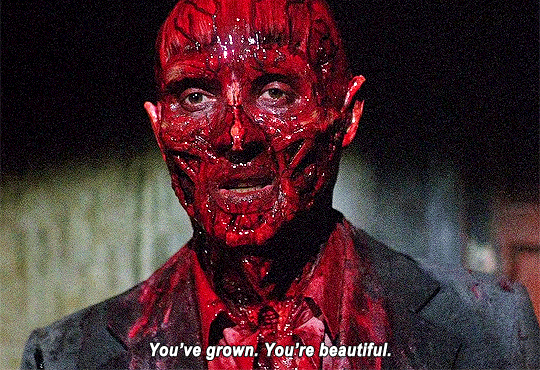
M: Well this one was actually made to be a Hellraiser story, unlike six others in this series. PART THE TWO. Kirsty is brought to an institution after the horrible events of Hellraiser (1987), where the occult-obsessive head doctor resurrects Julia and unleashes the Cenobites and their demonic underworld. This one is probably my favorite, ten times more crazy cenobite shit, way more Pinhead.
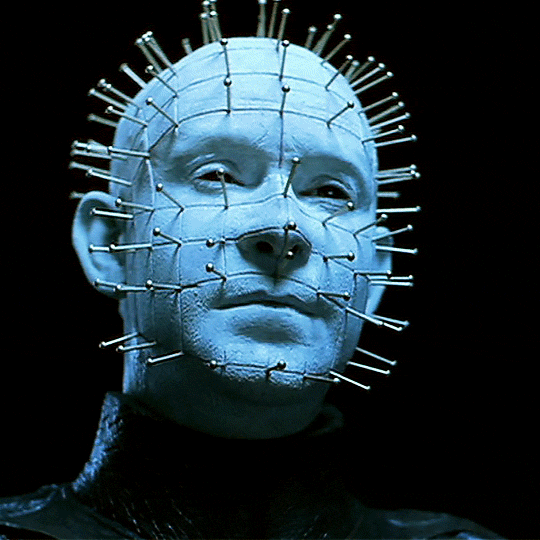
B: We get to see their weird liminal space hell and Leviathan, the giant rotating space diamond. It's weird and out there, and that's pretty cool. Clive Barker created such a unique impression and aesthetic of Hell. So weird and distinct.
M: It's amazeballs, some more really iconic lines from our boy Pinhead, and nobody but Doug Bradley could say that shit and make it sound cool. We know, we've heard other people try. It's bad. Also S tier.
B: Yup.
M: PART THE THREE. An investigative reporter must send the newly unbound Pinhead and his legions back to Hell. This starts the eternal trend of fucking detective/investigator/reporter nonsense in this series.

B: Like they couldn't think of ANY other plotlines. This movie is balls out, batshit insane. It's hard for me to delineate in words how bizarre this movie is. There's a guy who looks like Hulk Hogan who gets turned into a cenobite who kills people with his telescoping eyeball lens? There's Pinhead in a statue in a nightclub that just happens to be an art museum?? And Pinhead is just like, hey Nightclub guy you should just kill people.
M: It's fantastic. It's just utter chaos from the moment it starts. Pinhead spends half the movie trapped in a statue, he's so great. Sassy and unhinged Pinhead. The main character is some redhead named Joey who does stuff but we don't care because there's a fucking dude shooting cd's out of his cenobite mouth hole. I love this movie. Tons of Pinhead, tons of cenobites, some of the most iconic lines in the series here. S tier as well.

B: That's understandable. I'm willing to put it in A tier, but I like it an S tier amount. I will acknowledge it's not a great film, but it's fun as hell.
M: PART THE FOUR. In the 22nd century, a scientist attempts to right the wrong his ancestor created: the puzzle box that opens the gates of Hell and unleashes Pinhead and his Cenobite legions.
B: I can't lie...this kind of H.R. Giger shit that happened in the 90's...I fucking hate it. It's so fucking visually boring. Alien movies were good but ugh, I watched Event Horizon and it was BORING. This movie falls into that trap and I don't like it. Compared to the other movies in this franchise after this one, this movie is great. It's high cinema.
M: You're entitled to your wrong opinion about Giger and Event Horizon. I love this movie. It's so stupid. Hellraiser in space, c'mon. Most of the movie is about LeMarchand and we don't really care, but Pinhead has some of the BEST lines in the whole series.
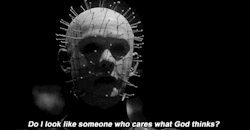
B: " Do I look like someone who cares what God thinks?" I love how Pinhead is this like, very serious Hell priest but then at the same time is very sassy.
M: Sassy Pinhead is the best Pinhead. Unfortunately after this, everything went straight into ass tier. I'm not willing to S tier this. This is at best B tier. Compared to the rest, this is still like...the best movie.
B: B tier is fair.
M: PART THE FIVE. INFERNO. A shady police detective becomes embroiled in a strange world of murder, sadism and madness after being assigned a murder investigation against a madman known only as "The Engineer". This is the first one where they made an entirely different movie and then slapped Pinhead into it. No really, they did that for like four movies. It's also the second movie that centers around a fucking detective.
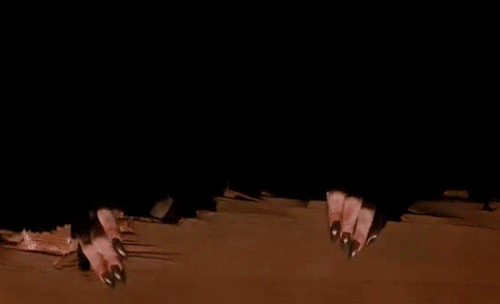
B: I feel a visceral hatred for this movie. It is a GRUELING experience. At the beginning, I was like, I'll give this a chance. It's not going so bad, it might be alright. But no, it just drags on. It's so, so fucking boring. You stop caring about this detective like a quarter of the way in. And this is the movie that begins the HORRIBLE, AWFUL, I FUCKING HATE IT trend of having fucked up shit happen and then have it be like OH IT DIDN'T HAPPEN. It was a hallucination or something. That's half the movie, stuff that isn't happening!
M: The original movies had a ton of fucked up shit happening, but it was ACTUALLY HAPPENING. That's part of why it was so insane. This movie is....painful. It is blindingly dull. They bring in the chatterer but he's just a torso. They throw in the wire twins and some like...slenderman motherfucker but it's just the detective.
B: They quit making new cenobites after this, they just recycled the same ones. They got rid of chatterer and butterball and female cenobite, kinda rude tbh. There's barely any cenobites in this.
M: Pinhead is here for like...literally two minutes.
B: It's a four course meal of just Saltines. Bland, dry, and unfufilling. Hell tier. Piss hell tier.
M: Whatever the worst, lowest part of hell is, this movie belongs there. PART THE SIX. A shady businessman attempts to piece together the details of the car crash that killed his wife, rendered him an amnesiac, and left him in possession of a sinister puzzle box that summons monsters.

B: At least this time, he's a shady businessman!
M: There are detectives tho. This movie brings back Kirsty, but like....she's a side character. The movie would have been way more interesting if it was about her. She manipulates her husband into the cenobites hands but WE DON'T GET TO SEE ANY OF THAT. It's all told from her stupid husband's point of view.
B: I remember him throwing up a lamprey but that was the only gross thing. If I wanted to watch a white guy lose his grip on reality I'd just go watch Hannibal. Or go look in the mirror.
M: SELF BURN. This movie is so boring. AND - it does the fucking this didn't really happen bullshit hallucination crap even more than inferno. It's slightly, and I'm measuring this is in millimeters, less boring than Inferno.
B: This one does have a lamprey coming out a man's mouth. It's still bad though. I have a hard time putting this is anything but shit tier as well. If I had to choose between this movie and staring at a blank wall for the same duration, i'd pick the wall, because then I could at least imagine a better Hellraiser movie. Still D tier.
M: I agree. It's awful. And now... PART THE SEVEN. Deader. A journalist uncovers an underground group who can bring back the dead and slowly becomes drawn into their world.
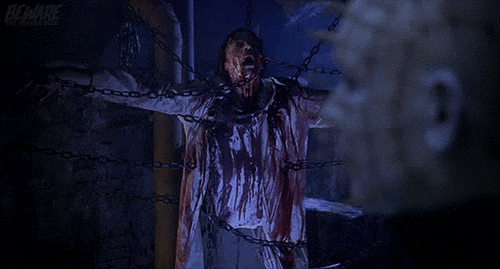
B: The cover for this one also looks like ass, look at that fucking photoshop glow around the cube, now just slap that girl's face on it. Who's more dead?
M: Yet another fucking journalist detective and we don't know what's really happening and what's not.
B: This one actually feels shorter than the other ones. The pacing isn't quite that slow but it's better than the other things. There's one or two visually interesting things. The guy on the train was kinda interesting. The scene where she has the knife in her back is compelling, the stark white of the bathroom and the blood. The scene with the dead girl in the bathroom also has tension. That's more than any of the other shit movies in here.
M: You're gonna give a rank up for not feeling eternal??? It's still awful. It is slightly less awful, the plot is really out there, there are holes you could drive a mack truck through. This one, like the past two though was also just another fucking movie that they threw Pinhead into and called it Hellraiser. Like...why does Lemarchand's ancestor have the ability to raise the dead?
B: It has a bit more merit as a piece of cinema than Inferno, which has nothing. It's like that gold star meme that says - not as bad as you could have been.
M: But can we rank it above hell piss tier? I mean really. We have like two rankings here...the first four, which we can't even compare these to, and then the rest against each other.
B: Compared to the originals, it's not good. It could be C tier, I guess.
M: I'm willing to go along with that, but it's still really really bad. PART THE EIGHT. HELLWORLD. Gamers playing a MMORPG based on the "Hellraiser" films find their lives endangered after being invited to a rave, the host of which intends to show them the truth behind the Cenobite mythos.

B: I'm almost willing to move Deader to C tier after remembering this one. This one is piss hell tier. Plot, that word doesn't apply to this movie.
M: The plot is....shaky...at best. This isn't remotely a Hellraiser movie. This is the WORST offender here.
B: The entire movie only has a Hellraiser themed party until the VERY END when Pinhead shows up for like a cameo and cuts a guy to pieces. It has nothing to do with hellraiser. The plot is a dude who's mad at his dead kid's friends because his son killed himself and he's seeking revenge.
M: It's more like a Saw movie tbh. Henry Cavill is here tho. There's a lot of banging and even more of the fucking this didn't really happen trope and also Pinhead is wearing a neck brace.
B: And at the end it's implied that a ghost used a phone to save his friends? There's nothing at all to do with Hellraiser. You could remove all the hellraiser iconography and it would still be the same movie. You could remove Pinhead and it would be the same movie.
M: Piss hell garbage tier. It's irredeemable.
B: These movies feel like being tortured by the cenobites in real life.
M: PART THE FUCKING NINE REVELATIONS JESUS CHRIST. Imdb won't load the synopsis. We already reviewed this one.

B: Jerma cries a lot, the movie.
M: I hate that I have to elevate this absolute piece of shit in the rankings, but it's at least a Hellraiser movie??? It's at least about Hell???
B: This one at least has some moments that are funny bad and not just bad bad. The unnecessary baby murder.
M: That's funny??
B: It's so hamfisted, it's so edgy, it just becomes comical.
M: This movie was made entirely so that they didn't lose the rights to hellraiser. Clive Barker said - and I quote - "I have NOTHING to do with the fuckin' thing. If they claim its from the mind of Clive Barker,it's a lie. It's not even from my butt-hole"
B: The makeup is so bad. He looks tacky, like if I reached out and touched him, he would be sticky. I don't like sticky airbrushed Pinhead.
M: They also messed up his eyes, it's just weird. This movie is laughably atrocious, but at least it's laughable. You can't even laugh at Inferno. You're too busy pulling your hair out. Regrettably, C tier.
B: It's poopy garbage and I don't like it, but compared to the other fecal matter I've had to review, it's slightly better.
M: PART THE FUCKING TEN OH MY GOD. JUDGEMENT. Detectives Sean and David Carter are on the case to find a gruesome serial killer terrorizing the city. Joining forces with Detective Christine Egerton, they dig deeper into a spiraling maze of horror that may not be of this world. Hey guess what? Fucking detectives.

B: This movie is really gross but it just feels way overdone. It loses it's shock value when you're being nasty 24-7. and I would know. A lot of these movies I was like - not nasty enough! This one...maybe build up a little.
M: This is a different kind of nasty tho, like there's barfing. A lot of barfing. And playing in barf. And drooling, and splashing blood on naked chicks and it honestly feels a WEE BIT FETISHY to me.
B: You're talking about Hellraiser, it's always been kinda fetishy.
M: I don't feel like it was Hellraiser fetishy, I feel like it was director fetishy.
B: They blew their load way too early. You can't just come out of the gate swinging like that. It's not as bad as some of the other ones. There's some Hell stuff in it at least.
M: I kinda like the Auditor.
B: I liked the weird butcher guy. The auditor guy is kinda cool but you can tell he can't hardly talk with that makeup on because he can't move his upper lip. I hate all the detective shit. There's no explanation of why this one detective guy went bonkers. I don't like the angel chick, she feel really out of place.
M: The Pinhead is at least better, though I wish they'd never showed the actor without the makeup. He also looks way overdone, like they hit him with some flocking.
B: Way too airbrushed. His lips are kinda blue. Blue lips, pale face, I hate the entire human race.
M: Still...in the grand scheme of things...not the worst. I still can't even go to B tier. I could go C tier.
B: B tier has four, we're not going there. It's still bad and I wouldn't advise that you watch it, but comparatively....it's better.
M: And the bar is SO LOW. Like we got excited that Deader didn't feel six hours long. That's how low the bar is. I will never forgive these people for what they did to my boy, MY BOY! But thank you Doug and Clive for giving me the first four. We are tentatively very excited about the new Hulu version.
B: "Look how they massacred my boy!" - The Godfather, 1972.

#hellraiser#hellseeker#deader#judgement#hellworld#pinhead#cenobite#clive barker#revelations#bloodlines#my boy#munchflix#review#tier list
19 notes
·
View notes
Text
Final Fantasy IV Review
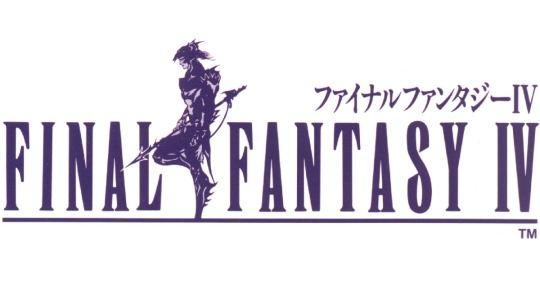
Year: 1991
Original Platform: Super Nintendo (Originally introduced to Western audiences as Final Fantasy II, since the real II and III were not released outside of Japan at the time.)
Also available on: Nintendo DS, PSP (Final Fantasy IV: The Complete Collection), GameBoy Advance, Playstation One (Final Fantasy Chronicles), Steam (DS remake)
Version I Played: PSP
Synopsis:
Cecil Harvey is Batman a dark knight who follows orders from King Baron. The king tasks Cecil and his partner Kain with taking the crystals from the surrounding nations and cities. Cecil questions his king’s motives, leading to the revelation of a grand conspiracy. Cecil then goes on a quest to right his wrongs.

Gameplay:
The novel feature of this game was the ATB system – Active Timed Battle. This means that instead of you and the enemy waiting for your respective turns one at a time, each character takes their turn according their respective speed. One character may be slower than the other, so they will take longer to be able to perform an action. Basically, with ATB, if you wait too long to think about what to do on your turn, the enemy can hit you - JUST AS IF YOU WERE REALLY BATTLING IN REAL LIFE.
While Final Fantasy IV introduced ATB, it did not utilize the ATB gauge in actual battles. The ATB gauge is a visual bar during battle that shows your character’s speed. Whenever it’s filled, your character can perform an action. The gauge itself was first seen later in Final Fantasy V. Later remakes of Final Fantasy IV displayed the ATB gauge. Some configuration options were introduced later to give you the ability to change the battle system to active or wait. Putting it on wait would allow the timed battle to pause while you thought about what to do during your move.
Final Fantasy IV forsakes the customizable Job System and introduces characters with individual jobs. Kain is a dragoon, who can jump in the air and deal destructive damage. Rydia is a summoner. Yang is a monk. Etc, etc.
The Super Nintendo and PSP versions are more or less on par with each other in terms of difficulty. The Nintendo DS remake is really hard. Like REALLY hard. Like “throw-your-DS-across-the-room hard”. I myself have had trouble finishing it.
Graphics:
I haven’t played the original SNES version of Final Fantasy IV, but judging by the images it appears to be in this liminal state between NES and SNES. Not quite NES but not quite utilizing the full power of the SNES either.

The PSP version is somewhat reminiscent of the Anniversary Editions of Final Fantasy and Final Fantasy II, but it still has its own flair that outshines them.

Final Fantasy IV DS is pretty much a 3D remake in the same vein as Final Fantasy III DS, with an awesome opening FMV. The in-game cutscenes however now have VOICE ACTING.
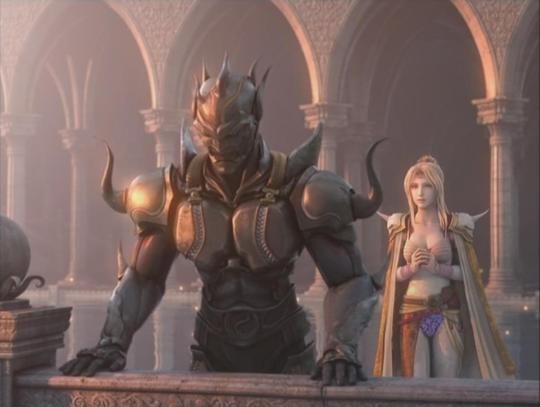
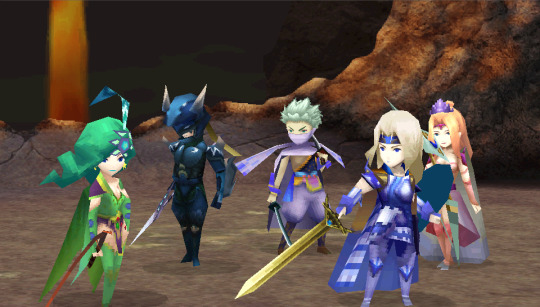
Now, the PlayStation One version has a FMV sequence that hasn’t aged well at all. We’re talking worse than the Final Fantasy and Final Fantasy II FMV sequences from PlayStation One. I can’t even find a good snapshot from Google Images, probably because nobody wants to look at them ever again. You can find it on YouTube though.
Story:
Final Fantasy IV is well known for being the first GOOD story in a Final Fantasy game. Cecil’s personal journey of redemption rung in the minds and hearts of audiences. There’s a nice balance of focusing on individual struggles and an epic adventure to save the world.
The cast of characters is pretty wide. Like Final Fantasy II, several secondary characters come and go. There is one difference but I don’t want to spoil anything. I guess the least I could say is that Final Fantasy IV subverts what to expect after having played Final Fantasy II.
Like Final Fantasy III, Final Fantasy IV includes crystals as an important plot device. This time they hold enormous power that the villain Golbez wishes to obtain for nefarious means.
While the story is infinitely superior in storytelling to Final Fantasy II, there are still some silly moments. I could best describe the bulk of the story as “Cecil and friends are on a race to capture each crystal around the world but something always gets in the way at the last minute.” While for the most part the story is done well, there are seemingly cartoonish moments involving random trapdoors and bewitched dolls. One particular moment I found myself thinking, "So you're just going to stand there while he does that?"
But I think the most admirable part of the story is how they approach Cecil and Rosa’s romance. While most RPGs, especially today, try to hash in a childish romance subplot, Cecil and Rosa are that rare couple that are already together at the beginning of the game. Their love is tested throughout the story.
The most popular quote from this game involves a complicated matter of translation. Western releases of Final Fantasy games (and Japanese games in general) often had awkward translations. “You spoony bard!” is one such awkward translation that originates from this game.
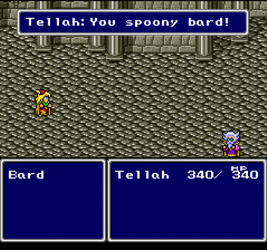
The character who spoke this line, Tellah, is arguing with the character Edward. The translation came out at “spoony” due to the Japanese writers believing it was still used today in English. It’s an archaic term meaning “enamored in a silly or sentimental way”. It technically fits, but clearly, nobody uses that word anymore, and players laughed at how nonsensical it seemed.
While I don’t want to spoil why Tellah is angry at Edward, the scenario in question is dramatic, and so Tellah saying “idiot” or “moron” wouldn’t quite suffice. The original Japanese word that Tellah uses is “kisama”, which in the given context is akin to telling someone they are a “son of a bitch” or “bastard.” Western releases, especially North American, were very often censored and demanded less or no profanity.
Overall, Final Fantasy IV is the first notable story in the Final Fantasy series, way better and much more original than Final Fantasy II.
Music:
With the Super Nintendo, Uematsu was able to play with more sounds. The drumming that Uematsu had wanted in his battle themes is more apparent. He also added an accompaniment to the Prelude. The main theme of Final Fantasy IV is scattered throughout the score, just like a motif in a movie score. The main theme is the map theme, and I like how, for example, the theme changes to a different beat when you venture into the underworld. The main theme even pops up in the final battle, which to me is awesome because it illustrates the heroes collectively trying to banish evil.
In one interview with Uematsu, he stated he was a huge fan of Elton John. For some reason, after I read that, I totally see the main theme of Final Fantasy IV having an Elton John vibe, especially in the epilogue with the drums and the bass.
Red Wings, which is the theme for Baron’s elite air force of the same name, is notable for its unorthodox time signature. I swore I read that somewhere years ago but now I can’t find it, so if someone happens to come across it – let me know. The theme for the Red Wings sounds both heroic and sinister, referencing Baron’s underlying motives and Cecil’s dual nature.
Cecil and Rosa’s love theme is actually taught for schoolchildren in Japan as part of their music curriculum.
Uematsu pretty much matured at this point, in my opinion.
Notable Theme:
There are so many but my personal favorite is “Dreadful Fight”, a.k.a “Battle with the Four Fiends”.
youtube
I’ll also highlight the “Theme of Love”, because it needs to be out there as the first love theme for the Final Fantasy series.
youtube
Verdict:
Hands down, the perfect place for a beginner. You want to start getting into Final Fantasy? Start with Final Fantasy IV. The gameplay is easy to pick up. The story is simple and straightforward compared to the rest of the series but still effective. To those having played the later games first, it could seem trite. Unlike most of the Final Fantasy games, the different re-releases can be quite offer a different experience due to the translations, graphical changes, and differences in difficulty. At the end of the day, I would say any 2D version is fine, the best is probably the PSP version, but save the DS remake for later, since it is more difficult.
Direct Sequel?
Yes. Final Fantasy IV: The Complete Collection was released on the PSP in 2011. This is the version that I played. Square created two sequels for that collection: Final Fantasy IV: Interlude and Final Fantasy IV: The After Years. I haven’t played them myself yet, but there is criticism surrounding their stories, which apparently pale greatly in comparison to Final Fantasy IV.
By the way, the PSP version starts by showing the new FMV opening to Final Fantasy IV: The After Years, not the one shown in Final Fantasy IV DS. That’s a minor change but it really irked me, because the sequel’s FMV opening therefore spoils some of the story if you never played it before. I guess they wanted to distance themselves from Final Fantasy IV DS. Even so, why not just play that opening when you select The After Years?
#final fantasy#final fantasy iv#cecil harvey#rosa farrell#nobuo uematsu#square enix#onvideogames#video games#rpg#video game rpg#fantasy
39 notes
·
View notes
Text
YK Live Vol. #15 Chiba - Setlist
Yuki Kajiura Live Vol. # 15 ~The Junction of Fiction~ [June 28] @ Ichikawa City Cultural Center (Chiba)

I finally got the chance to look closely at the leaked setlist and since we already got our first reports from the live, I was able to fill in almost everything that I couldn’t make out before. The only thing I am still wondering about is the first song. People are saying different things about it. And I am a bit confused about “vanity”. I think it says “Japanese version” next to the song title but so far no one has mentioned that the song was sung in Japanese o.O The setlist is subject to change (I will be updating the post whenever I find any new info).
1. overture ~ the main theme Kimetsu no Yaiba 2. old fashioned fairy tale MC 1 3. fake wings 4. I swear 5. my long forgotten cloistered sleep 6. petals and butterfly 7. he comes back again and again 8. absolute configuration MC 2 9. 星屑 Hoshikuzu 10. 風の街へ Kaze no Machi he 11. elemental 12. storytelling 13. moonlight melody MC 3 14. fiction 15. vanity 16. in the land of twilight, under the moon 15. avant title 18. you have to choose your fate 19. lancer and assassin MC 4 20. liminality 21. the battle is to the strong 22. MATERIALIZE MC 5 23. I reach for the sun ENCORE : overture ~ L.O.R.D. theme EC 1. stone cold EC 2. zodiacal sign
#news#yuki kajiura#keiko#yk live vol 15#so many keiko-heavy songs <3#kaori#joelle#yuriko kaida#yuri kasahara#yuri shinada#setlist#chiba
31 notes
·
View notes
Text
Fermentation & Feminism
[...] it (fermentation) materialises a ‘symbiosis between species and coevolution, accessibility and bioavailability, conservation and transformation, future and survival, which are related to biodiversity, for instance, and finally to the reduction of damage and care. Both of oneself and of others.’
Fermentation is a natural process of enrichment in which the ‘mother’ procreates, regenerates, feeds, cares and self-replicates or updates herself. In its physical and figurative versions, for Fournier this is a way of approaching contemporary transnational feminisms. Its main interest lies in its double capacity to preserve and change, ‘that ability to preserve, retain and honour the past and at the same time transform, take on new shapes and configurations’.
This is a symbiotic relationship between species in which human beings do not exert their superiority but merely collaborate; as such, it is understood as an intersectional feminist activism. Fermentation as sorority; a physical connection. We eat in order to be connected: we introduce microbes into our microbiome and, in their turn, they introduce us into their ecosystem.
Fermentation is, therefore, a liminal practice situated on the margins of art, science, technology, design, cooking, the preparation of beverages, witchcraft and speculation.
0 notes
Text
Digestion of:” The Brain on Ritual: How Tantric Puja Shapes the Mind”
The Brain on Ritual: How Tantric Puja Shapes the Mind The paper does not make an attempt to discuss the efficacy of the ritual, but instead creates discussion on the linkage between the liminal ritual experience and the social behaviors practiced therein, and how that may be transferred via ritual practice into the mundane, non-ritual experience. This explanation in large part draws upon the work of Larry Barsalou in embodied cognition, and I believe I had read in the acknowledgements that Barsalou had personal correspondence with the author, offering their time and expertise to the author’s efforts.
Barsalou’s work, and the work shown in this paper has personally expanded my vocabulary in analyzing these processes, and the terms that I want to highlight for further discussion/direct use in ritual practice are mainly explained in the paper in pages 32-37, and are as follows:
Feature map
Part-to-whole inference
Simulators and Simulations
Entrenchment, Pattern Completion and Reenactments
As the paper notes, these concepts are important in imagining the processes by which experiences affect the body and the mind. I believe they also provide possible mechanisms with which to work with in order to determine the necessary components of a constructed ritual, use and configuration of components in order to affect efficacy of ritual, as well as to help establish patterns of behavior in order to reinforce the intended ritual outcome.
--- I mentioned earlier that Catherine Bell’s work regarding ritual practice forms a large part of the foundation of the paper, but the author somewhat diverges from previously implied importance of Bell’s work with the paper, as the paper’s purpose seems to approach its intended purpose. They explain that Bell’s work is limited in that it is formed around a sociological driven approach, that the paper itself acknowledges as limited in its usefulness for discussion of the individual impact of ritual practice on individual physical bodies and the mind. However, the following excerpt from pages 62-64 illustrate the author’s overall integration of Bell’s work with Barsalou’s (block edits by me to help make more intelligible absent context):
“According to Bell, ritualization is a productive method for social construction. Bell argues that ritual’s ability to use the body and bypass the participant’s conscious mental awareness is one of ritualization’s most potent qualities; the practitioner does not recognize that ritual participation changes the way he acts outside the ritual space or that he internalizes specific social priorities through religious ritual practice... For Bell ritual causes an individual to act without engaging in conscious decision making, and as a result of this his behaviors appear to be automatic. Barsalou’s concept of part-to-whole inference offers insight into the mechanisms that might beat work in this apparently automatic behavior. As seen earlier, repetition of ritual actions entrenches neural networks,and given the mind’s propensity for pattern completion this makes information processing in these networks occur quickly. According to Barsalou, when any aspect of a particular neural network is activated it can cause the entire network to reactivate creating mental processes that drive behavior. For example, in [the studied ritual] the tradition holds that the practitioner’s sensory awareness is replaced by that of the deity, thus they experience the world as the deity would. When the practitioner is in a social environment that shares elements of the ritual environment any one of the shared elements can activate the simulator of the [studied ritual.] This activation can cause the practitioner to experience the social event from the perspective developed during [the studied ritual.] Using Barsalou’s model, rituals like [the studied ritual] can be understood as generating a type of bodily experience and expertise that can be reactivated in ritual and non-ritual environments through part-to-whole inference. As a result the practitioner’s behaviors are driven by the religious and social priorities internalized during [the studied ritual.] This process may occur so rapidly that the practitioner appears to act automatically and unconsciously. Bell refers to these as unconscious behaviors, but it may be more productive to think of them as differently conscious, a consciousness that is bodily as opposed to a linguistic or consciously analytical.Thus, ritualization and the behaviors that it generates can be understood as something other than a type of social construction. Ritual practice may be a method for constructing a type of ―embodied logic.”
In terms of my earlier sharing of her work re: the ritualization process and its divorce from conscious awareness in affecting the outcome of ritual practice: the “blindness” or “misrecognition” that she points to as key to transferring ritual acquired dynamics to outside social contexts I theorize should be looked at less as a primary mode of function, but rather a method by which the efficacy may be boosted, via some other mechanism such as suspension of disbelief or a closed-label placebo effect. As such, there remains the implication that it may be possible to still conduct rituals with appreciable outcome, regardless of awareness of the mechanism. Depending on the structure of the ritual and the practice, I hypothesize that this aspect can be mitigated/circumvented by relying less on the established mythology of religion, and focusing more on less symbolic processes of ritual.
This is supported by the paper’s extensive use of Barsalou’s work on embodied cognition to establish a linkage between the ritual and mundane experience. Given the strong support the paper was able to establish in making their argument via Barsalou’s model, I’m tempted to use Barsalou’s work as a working model to create a methodology towards ritual construction. At the very least, it provides support in the idea that directly tying an explanation for ritual process and function to a cognitive model is a compelling way to argue for an explanation of the creation of association between abstract concepts and concrete experience. I believe directly referring to a cognitive model should be a basis of best practice for ritual construction.
---
The main takeaway that I had in this reading is that by establishing a possible mechanism for the transference of ritual behaviors and modes via cognitive psychology, we can then more effectively construct ritual. The paper reinforces this by supporting their main argument centered on religious study and cognitive psychology, by introducing evolutionary anthropological theories on the co-evolution of religion and cognitive function, citing work by Pascal Boyer and Steven Mithen (pages 26-31) which they cite as influential in cognitive science at the time of writing.
I am specifically optimistic at the lead that “part-to-whole inference” offers in ritual construction, as it provides a basis by which reactivation of the emotional and mental states achieved through ritual practice can be triggered by mundane stimuli. By the creation of a feature map via ritual practice, and by which intentionally creating associations between individual abstract concepts and mundane sense experience, we may be able to draw limitations/guidelines as to the extent of which intent (in the witchcraft sense) can be effectively conveyed and reinforced via ritual component. The reactivation of the feature map via part-to-whole inference, using the mundane ritual component as trigger can be seen as a mechanism by which “spellwork” can be engendered/activated during ritual, and transferred out of ritual context via somatic, verbal and material components that were integral to the ritual itself. By using the cognitive mechanisms of entrenchment, pattern completion, and reenactment, the efficacy of spellwork can be further boosted/reinforced as practice is continued over the long term. This offers an alternative explanation/construction compared to the widely touted “open-label placebo” explanation, though I do not close that off as an important mechanism by which ritual, and by extension witchcraft practices can be structured. In fact, I believe that it can be a very key component in the intention setting portion of ritual construction, and its continued efficacy over the long term. But that is separate from what I believe are also important, and more immediately relevant, conclusions that I’ve drawn from this paper.
1 note
·
View note
Text
Karen Tidbeck, Weird Writer
I recently finished Amatka, the debut novel of Swedish writer Karin Tidbeck, first published in Swedish in 2012, and published in English earlier this year in the author’s own translation. Previously I had read Jagannath, her debut collection of short stories.
Tidbeck is often described as a writer of “weird” fiction. This is not an inaccurate label; her fiction is indeed weird. In “Beatrice,” the first story in Jagannath, a man falls in love with an airship (not in an abstract way—in a “they have sex” kind of way), and later a woman gives birth to a child who is half steam engine, for example.
“Weird fiction,” as a genre, is not easy to define. Its history predates H.P. Lovecraft, though he is credited with popularizing the term, and his particular blend of science fiction and horror has been associated with the genre ever since. It is a sort of liminal genre, overlapping other genres; stories usually considered horror, science fiction, fantasy, or surrealism could also be considered weird. The weird also appears in many stories that blur genre distinctions: weirdness tends to defy classification. In recent years Jeff and Ann Vandermeer have made noble if doomed attempts, with their anthologies The Weird and The New Weird, to impose order on a mind-boggling array of stories which often don’t share much beyond a fascination with and terror of the unknowable nature of reality. This terror is certainly an identifiable trait, and an interesting one; whether it constitutes a coherent genre is up to you.
I tend to think that “weirdness,” in the broadest possible sense, is an essential quality of all good fiction. If a story is not in some fashion weird, it can say nothing new. Of course I have made many dubious aesthetic judgements in leaping to this conclusion: that fiction must say something “new” to be “good,” that fiction must “say” something, that “weirdness” and “newness” are intrinsically related qualities, etc. Suffice to say there’s a lot of nuance I am willfully ignoring here. My point is this: Stories have the power to unsettle reality. By offering new ways of looking at our experience as human beings, they can make us question our deepest assumptions about what is true. The best fiction (in my opinion) generally achieves this effect, or something like it, even if it’s not the main point. In weird fiction, often this unsettling effect is the main point.
The less successful stories in Jagannath have a bit of this “weird for weird’s sake” vibe, feeling slightly flimsy as a result. Take the aforementioned “Beatrice.” Why exactly does Franz Hiller fall in love with an airship? Why does Anna Goldberg enter into a relationship with a steam engine (named Hercules, no less)? I don’t honestly know. Tidbeck’s intent with the story is a mystery to me. It is not, I want to emphasize, a poorly executed story. Tidbeck is a great writer; her language is controlled and precise, and she skillfully sustains a distinct deadpan tone. I simply don’t get what she is doing. She succeeds in showing the world from a new and surprising angle, but where does this angle intersect with reality? What does it illuminate or reveal?
Speaking as a non-fan, I think the reason H.P. Lovecraft’s fiction endures—despite its many well-known shortcomings—is that, fundamentally, he is trying to communicate what he believes to be true about the world. Lovecraft believed that human beings were the insignificant playthings of a malignant universe full of incomprehensible terrors. It’s this bleak vision of reality, rather than the winged bipedal squid-aliens, that makes his writing truly weird.
Jagannath doesn’t immediately assert such a vision, but feels at times like a series of exercises and experiments; it’s hard to tell at first what, if anything, Tidbeck believes to be true. (Although, to have written these stories, she must believe in the power of her own imagination and in her talent as a writer—beliefs she quickly proves justified.) It’s not that the stories lack style. They’re unified by a habit of dry understatement and a certain emotional remoteness, a frigidity some have identified as characteristically Scandinavian. (I don’t know how she would feel about that.) It’s a technique with mixed results. While she successfully avoids the frothy melodrama of Lovecraft, at times her subject matter seems to demand language a little more...heightened?
In “Brita’s Holiday Village,” for example, the narrator stays at a relative’s resort over the summer while struggling to finish a novel. Suddenly an enormous extended family moves into the cabins, having apparently rented the resort. The family’s behavior is eerily artificial; it is implied that they may not be human. Then:
“Last night and the night before last, it happened several times that I walked into a house and people were having sex. On all surfaces, like kitchen tables or sofas. [...] And it’s everyone on everyone: man and wife, father and daughter, mother and son, sister and brother. But always in heterosexual configurations. I asked Sigvard what they were doing.”
Here Tidbeck’s matter-of-fact attitude toward the weird feels more like an affectation or quirk than an expression of personal truth, the insistent flatness of tone a stylistic limitation.
Jagannath gathers strength, however, as it goes along. You can almost feel Tidbeck’s confidence building, her vision solidifying, as the stories grow longer, stranger, more intricate. The second half is generally better than the first, and two stories in particular near the end, “Aunts” and “Augusta Prima,” made me reconsider the whole collection; reading these stories, you feel that she has been working toward them from the very beginning, and is finally hitting her stride. Set in a rococo world of spectacular cruelty, “Augusta Prima” is a tale of demented courtiers playing an endless sadistic game of croquet in a mysterious garden beyond the reach of time. Every aspect of the story is alien, including the mind of the protagonist, who, in one scene, cuts out the tongue of her page without hesitation or remorse. Tidbeck’s subdued prose is at its most creepily dissonant here, and her exploration of time is fascinating; the story feels weighted with purpose in a way the earlier stories often do not. “Aunts,” set in the same universe, revolves around three women who ritually gorge themselves until they split open, at which point another generation of aunts takes their place, beginning the cycle by feasting on the dead women’s mammoth corpses. It is unsettling beyond belief—but here again, Tidbeck seems to want to unsettle you for a reason, and the story raises troubling questions about life and death, tradition, and (once again) time.
Amatka, Tidbeck’s only novel to date, is the equal of her best short stories, a very good queer speculative dystopian mystery thriller that doesn’t quite, in the end, coalesce into a great one—but dang, does it come close. It benefits from a greater emotional range than Jagannath—there is, of all things, a touching love story—and a sharper thematic focus, though I can’t help but feel that Tidbeck stops just short of saying anything truly new or remarkable about the relationship between order and chaos, individual and society, language and reality.
The nature of the setting is shrouded in mystery for most of the book, and much of the fun of reading it is trying to figure out where Amatka is. It’s a human settlement, one of four (though, ominously, there used to be five), somewhere in the middle of a vast and snowy waste. Another planet? Another dimension? Tidbeck has a great deal of fun teasing you with the possibilities. The thing about this place, wherever it is, is that all objects here—pencils, suitcases, filing cabinets, and so on—must be labeled and named aloud in order to continue existing. If you go too long without reinforcing your pencil, for example, by calling it “pencil,” or if you accidentally name it the wrong thing, it will lose its shape and dissolve into formless ooze. Due to the fragile nature of reality in this world, a kind of totalitarian bureaucracy imposes strict control.
I am in love with the ideas in this novel, particularly the idea of reality as a kind of societal consensus enforced by language: this is a “pencil” only because we all agree it’s a pencil and call it a pencil—so what happens if I disagree? However, the ending is a bit of a letdown. I don’t mind that it’s ambiguous, but in this case, the ambiguity feels like a cop-out, a kind of evasion, as if Tidbeck is retreating from the implications of her premise. She turns away from the questions at the heart of her narrative right when she should be grappling with them head-on, and the book ends abruptly when it should be kicking into high gear.
Karin Tidbeck is a gifted writer whose primary weakness is a certain monotony of affect. If she can learn to vary the intensity of her style, or to find new effective uses for the style she’s already mastered (as she does in her best stories), I think she has the potential to become one of the great modern weird writers.
1 note
·
View note
Text
TRANSMUTATIONS
The powerful charge of sub-sounds in nightclubs is something that is rooted in the affective conception of this music. A Dub heritage makes Jungle and Drum and Bass genres that present a strong personality relating to the use of subfrequencies. For me, a Jungle and Drum and Bass night is a really physically moving experience. Steve Goodman (aka Kode9)8 in collaboration with Cuban artist Tania Bruguera, opened an exhibition called 10,148,451 in October, 2018, at the Tate Modern in London.
He created sound design that includes a 40,000-watt sound system that fills the famous Turbine Hall with low frequency sound. This bass is a murmur that resonates within the bodies of the visitors, responding to the necessity of the artist “to really think about the contemporary migration crisis”.9
The heat-sensitive floor of the turbine hall undercovers an image that can only be revealed if people join together and add their body heat. This makes the visitors an active warm part of the piece.
I think it is not a coincidence that in this piece, the effect produced by the bass of a sound system and the heat of bringing people together is a feeling that inspires an affective artistic transmutation of factors that are a constant in clubs. In the next lines, I will draw on what Micah Silver calls “peak affective, communizing experiences” (Silver,2014,70)” as an element in the discourse of contemporary theory of sound art and other art expressions. In Club, it is the “affective charge” (Reynolds, 2016, 9) of sound with the use of the body as a medium of expression that configures the discourse of this culture.
This acts in tandem with and within other bodies transmitted through the stream of music and lights, creating the perfectly embodied, cognitive co-performance of the club arena. Vijay Iyer points out that “co-performance is made literal in musical contexts primarily meant for dance; the participatory act of marking time with rhythmic bodily activity physicalizes the sense of shared time and could be viewed as embodied listening”. (2016, 06)
This has a direct impact on the image, fashion, and even the struggle and healing of this present day counter-culture, clearly shown in the performance of 'Faust', that choreographer and ex-bouncer of the Robert Johnson Club in Offenbach, Anne Imhoff, presented in the German pavilion of the Venice Biennale in 2017. The artist brings the dancefloor interaction of in-betweeness and a communal group of bodies experimenting to an art setting. The audience and the performers are merged in a performative piece of art.“There is no choreography, established rules, just a flow of actions that arise based on circumstance”.(Ruffolo, 2017) 10
She mixed this with the aesthetics of the club, imagined as an art gallery, with the essence and fashion of a generation between the 1980s to 2000s. This is acheived with second-hand coats, sports pants, denim with jogging, bomber jackets, eclectic combinations of clothes merged in a random outfit, with the characteristics of a youth “driven by the inescapable connectivity of social media, and precarious economic conditions to inhabit a lonely state of pride and defiance”.(Kries et al. 2018, 177)
This performance involves elements of a contemporary, millennial way of life. The artist is part of the generation that habitates club spaces, contributes to, and reinvents them. She transmuts the main affect of being here with ourselves and with others produced in clubs into a piece of art presented in a major institutional exhibition far away from the club.
“Anne Imhof’s contribution is more intimate because it is based on the possibility of getting connected not with others but with ourselves first and foremost”.(Ruffolo, 2017)
The playback sound was triggered by a mobile device held by the sound technician who was part of the group of performers. The sound design was designed by Imhoff in collaboration with other artists. In the video we can see the artist performing the piece called 'Medusa Song', made of strong sub-bass sounds mixed with the artist’s dramatic voice. In the video, the architecture resonates in a way that is also apparent in clubs. The sense of self-awareness that Imhoff’s piece,in the German Pavilion produced, is a feeling naturally present in club settings as well as in the paths of many other music styles.
In the case of experimental music, Jennie Gottschalk writes in her book 'Experimental Music since 1970', that this music can “resonate with the unique experience of each listener”.(2017, 4) She uses John Cage’s 4’ 33’’ as an example of the experience this music produces in our perceptions and expectations of a sonic event.
The author relates elements that remain present in the evolution from original experimental music in the 1970s to contemporary electronic club music. The nature of Cage’s piece reveals a change of perspective, placing the attention on the body of the concert hall rather than on the performer. Here, space becomes present by not being excited in the way we expect, and because we are blind to a cue of the sounds that will be played, we maintain our minds in the moment of the experienced sound. This drives our attention to the process of sound around us.
Cage’s ‘instructions’ to the performer of the piece, is that there should be an absence of instructions, and this will generate the application of one’s own thought and perceptions. A DJ also must keep this absence to drive an experience in synergy with the crowd. Also, the selection of the mix should be, as in the Imhoff piece, based on circumstances.
By changing the focus from performer/listener, 4’33” has opened the possibility of each person’s tuning of their listening threshold. This allows us to be aware of and become immersed in the flow of sound, here and now, around us.
Gottschalk, defines the essential quality of the experience of self-awareness that this music holds:
“experimental music is about the time and place in which it occurs”, “When experimental music is effectively made and presented, it speaks to our interaction with the world. It goes from the center-what we already know-to the margin-what we don’t know-and back again, so that new realities are present along with, or sometimes even in place of, our previous perceptions of our own lives.”(2017, 4)
I think that this act of going to our unknown borders makes the process of awareness a transition that reshapes social and personal boundaries. It finetunes our thresholds, enabling new levels of perception. The way this retuning will develop is concerned with how our thresholds are built, making this a very personal transition.
Personally, the musical experience that introduced me to a concept of understanding the structures behind our expectations of sound, was Elianne Radigue’s 'Jetsunmilla'. This piece starts with a smooth progression of sub sounds modulated like an ancient guttural murmur. This extends for the whole score, changing slowly, gradually and softly to different tones, with sporadic semi-rhythmic higher ones.
For a less-aware sense of hearing (as was mine), the expectations of how a record starts were blurred softly as the album progressed. 4’33’’ on the other hand, instantaneously blurred these expectations at the time it was presented, opening the limits for new, self-aware listening and letting future generations experiment with an ecstatic evolution of the way of listening to music.
Tania Bruguera’s commission for the Tate Modern Museum worked with the space as Cage presented 4’ 33’’. Her intention was to make the Turbine Hall look like nothing was happening there. She wanted people to be made aware of the space by going through the experience and to receive her message in the process.
Hantelmann speaks in her text 'The Experiential Turn', that art’s “reality-producing dimension”(2014)11 or the bodily experience of artwork, exists as a situation that forces us to change somehow our perspective of reality. She argues that this “includes a specific methodological orientation that goes along with the performative”.(ibid) This performative use of the body is usually orientated towards being mixed with effects that hack the appearance of the surrounding situation, manipulate the scale of space, and/or modifies the aural reality. This pushes the spectator to complete the artwork and play a new co-created reality with its body and the work.
Bruce Naumann’s 'Acoustic Corridor' of 1969 is a clear example. This piece creates a mixed acoustic reality, with a sound absorbent wall on one side and a normal painted surface on the other. It disorients the spectator’s ears, giving a sense of how our aural perception is built.
In the club, the reality created by audiovisual technology, the kinetic performing bodies and the dissolution of visual structures, is a pulsating reality that is far away from our everyday experience. The ecosystem working synergically with you, me and the others, produces new realities that contain a huge affective potential. Therefore, I would say that the meaning in a club is first received individually, but is rooted in a strong way to the meaning developed by other dancers.
Sociologist Silvia Rief states that clubbing:
“...assumes positive notions of transgression into liminal states, in which ‘other modes of being, activity and living can be explored.” Much of this “other mode of being” is explored through the one activity that unites all of the club culture: dancing.”12
So if we continue to consider this relationship between parallel ideas in the arts and club, I can argue that both parts denote something that is located within the the artwork or the club structure and needs to be “read” or “discerned” by a viewer”.(Hantelmann, 2014)”
According to Hantelmann “It certainly produces an experience, though, in the way that it relates to the space and to the viewer’s body.”(2014)
In her text, she cites sociologist Oskar Bätschman to introduce the term ‘experience shaper’. The term alludes to a situation intended to influence perception, or shape our ‘experience’ of reality in a certain way. These ways are linked with the artistic concept choosen for each proposal. The conception and particularities that each artist/collective pick to produce a new experiential piece, creates a phenomenom that begins when the spectator chooses to become co-actor in the ‘reality game’ of the artwork.
This can also be detected in Club, between DJ’s, dancers and the space. The experience shaped by Club is a new reality that can be completed when the dancers decide to enter the game proposed by the DJ (set) in the Club (setting) over a technological field of tension. Here, I will underline that this experience is shaped also by the crowd and is not a experience that can be experimented individually, or detached from a group.
In the vision of this work, the interconnections that happen in the moment of Rave, give a technological entity to the concept of experience shaper coined by Bätschman. This work sees the Club as an experience shaping device. This entity provides the notion of a technological meta-structure that influences and supports the hyper-technological act of Rave. This meta-structure could be the sound system, (turntables, mixers, media reproducing devices) as well as psycho/chemical and other technologies of the self.
7
Krzysztof Wodiczko and Ani Liu imparted a seminar-workshop at Harvards Graduate School of Design in 2019 titled: “Entanglement of Movement and Meaning: The Architect, Spatial Perception, and the Technological Body” see: https://www.gsd.harvard.edu/course/entanglement-of-movement-and-meaning-the-architect-spatial-perception-and-the-technological-body-spring-2019
8 Kode9 is the alias that Goodman uses for his artistic manifestation as a DJ, he manages Hyperdub a well known British label, of underground UK electronic sound that is famous for the heritage of dub music. Bass based music is a common presence found in most of UK genres. (Jungle, Drum and Bass, Dub, Dubstep)
9 See: Pearl, Max. Kode9 Installs 40,000-Watt Soundsystem in Tate Modern. Resident Advisor, 1 Oct. 2018, www.residentadvisor.net/news/42581.
10 Ruffolo, Mattia. “Breaking down the German Artist Anne Imhof’s Astounding Venice Biennale Pavilion.” I, VICE, 23 May 2017, i-d.vice.com/en_uk/article/d37gkm/breaking-down-the-german-artist-anne-imhofs-astounding-venice-biennale-paviliona
11 See (Hantelmann, 2014)
12 Silvia Rief in (Kries et al, 2018, 19)
0 notes
Text
Workshops+Talks

Spoiler Alert: The White Ego Dies
Talk and discussion with Danny Pagarini // 17th March 2018 // 15:00-17:00 // Market Corner Gallery
Steven Claydon says “An art work should…be operative…in that…liminal space between the thingly and the metaphoric or the narrative.”
Danny Pagarani says “What?…And that’s why you made replicas of those Papua New Guinean masks?”
At a time where the Conservative government of Theresa May, weak and bereft of ideas, is actively encouraging culture wars it is important to have a clear sense of what identity is and does. Danny will use Steven Claydon’s exhibition Archipelago of Contented Peoples (Common Guild, 2017) and the questions around ‘cultural appropriation’ it raises, to argue for the need to think about the performative, intra-acting configurations of history and power in which our conceptions of subject, object, self, other and identity continue to emerge. The presentation will be followed by a discussion.
Event is free and unticketed.
Facebook event
Information on accessibility: https://inresidence2018.tumblr.com/Accessibility

intersections, collective care & collective love
Workshop with Aki // 18th March 2018 //12:00-14:00 // Market Gallery Corner Space
Kimberlé Crenshaw first coined the term ‘intersectionality’ in 1989. It is often used in critical theories to describe the ways in which oppressive institutions (racism, sexism, homophobia, transphobia, ableism, xenophobia, classism, etc.) are interconnected and cannot be examined separately from each other.
Closely referencing and expanding on Crenshaw’s ideology, Aki will facilitate a workshop where participants will work together to clarify their own backgrounds, privileges and position in the society.
This workshop will supply you with introductory material in regards to intersectionality, its derivation from Black feminism and some key tools that will guide you to apply this concept in everyday life. Aim of this workshop is to acknowledge that intersectionality is a collective effort, and that it essentially begins with self-evaluation and self-love.
[Image description: Abstract image, with a red triangle on a brown back ground. There are then diagonal lines, curved lines and tildes dispersed along the page.]
This workshop is only open to people of colour.
Event is free but ticketed: https://www.eventbrite.co.uk/e/intersections-collective-care-collective-love-tickets-44126378185
Facebook event
There are only 8 spaces so please book soon and if you are unable to go, please email us at [email protected].
Information on accessibility: https://inresidence2018.tumblr.com/Accessibility

Continued
Performance // 18th March 2018 // 13:00-15:00 // The Pipe Factory
A continuation of the performances from opening night with work from Samantha Alexa and Huss.
Huss is Middle Eastern artist based in Glasgow, Scotland. Not bound by mediums, Huss works in a diverse array of specialisms such as installation, sculpture, performance and painting. Huss finds it important that he uses his work as an instrument to spread awareness about major issues originating within the Middle East or Third World Countries which Western society don’t acknowledge. Huss investigates concepts such as racism, ethnocentrism and xenophobic behaviours. His main source of influence comes from his own personal experience as a Middle Eastern within Scotland as well as the inner conflicting emotions felt for both the country he resides in, his culture and his country of birth.
Samantha Alexa was raised and educated in California, where she attended various summer camps and programmes including San Francisco’s Academy of Arts and California State Summer School for the Arts. Given her innate visual art abilities and ballet training of ten years, she chose to leave public school to pursue a more creative education. She joined Idyllwild Arts Academy, a boarding school where she lived and studied for three years, majoring in theatre. Shortly after graduating at the age of 18, she successfully campaigned to raise money for her first film, which she then went on to direct and edit. Her education then took her to Glasgow, Scotland, where she studied Contemporary Performance Practice at the Royal Conservatoire of Scotland. There she learned it was possible to combine all these different disciplines of art bringing her creative journey full circle.
Re: Generation is
a nurtured creation.
a rebirth to inner power.
an expressive exploration of the metaphysical.
a futuristic journey of colour sight, sound, & movement.
a performance about reclaiming the body & mind.
about finding dimensions of divine.
A collaboration between
Samantha Alexa x Vaj. Power x AUCO
[Image description: Three frames of someone shaving their face with the word ‘Continued’ layered on top.]
Event is free and unticketed.
Facebook Event
Information on accessibility: https://inresidence2018.tumblr.com/Accessibility

In Conversation With Shaheeda Sinckler
Talk with Shaheeda Sinckler // 18th March 2018 // 15:00-16:00 // Market Gallery Corner Space
Shaheeda Sinckler is a Glasgow based artist, originating in London and half-raised in Edinburgh. Concerned with the politics of gender and race, Sinckler’s work investigates the complex and varied identities of a woman within her relationships, with others, and herself. She is a co-founder of Where People Sleep, an art gallery and exhibition space that exists inside a tenement space. Independent, homegrown, and artist-run, Where People Sleep aims to give artists a platform in a space free of judgement, encouraging experimentation and boosting confidence. The In Conversation, hosted by Karin Tokunaga, will explore the journey which has led Sinckler to become a multi-disciplinary artist who has left no stone unturned.
[Image description: Text reads ‘In conversation with Shaheeda Sinckler’ in black on a green background]
Event is free and unticketed.
Facebook Event
Information on accessibility: https://inresidence2018.tumblr.com/Accessibility
0 notes
Text
Mökki, Upscale living in Astana, Kazakhstan
When the name Astana is thrown into the mix of other world cities like Tokyo, Sao Paulo or Jakarta, it always leaves a few heads nervously being scratched: simply, most haven’t even heard of it. And for those that have, it’s considered an eerily unreal place. Amidst countless, hundreds of miles of Kazakhstan’s arid flatlands, with the space’s sense of mystery thickened by tales of secret Soviet weapons testing and the Iron Curtain rhetoric of the Cold War, Astana, boldly reaches to new heights as a beacon for the country’s ambitions. Its streets are meticulously planned, surreally methodical, and neatly compartmentalised so that the entire place’s sense of composition and order is shown in a total, almost aggressive, beauty.
Direct your gaze upward, and the city becomes a chaotic symphony of glass and polished metal, contorted into ever more adventurous forms with each building vying to make a statement grander than the one that neighbours it. Needless to say, Astana knows no such thing as hushed tones when announcing its presence on the world stage.
This said, Astana’s fiercely metropolitan ambition has opened the city’s doors to high-end names and businesses from all over the world, with The Ritz-Carlton being one of these. A name that requires no introduction, this newest addition is a five-star hotel which boasts an elevated location in the city’s Talan Towers, a vantage point from where guests can lose themselves in uninterrupted panoramic views of Astana’s ambitious skyline.
The interiors aren’t exactly shabby either. An ideological mix of the Ritz-Carlton’s reputation honed on delivering with excellence, paired with Astana’s quirkily insatiable appetite for all things, bigger, faster, and bolder, meant that a space, undeniably luxurious and yet laden with the Astana’s brash confidence, and yet, searching sensibility would take shape – Mökki, an elegant restaurant situated in the hotel’s third floor, certainly is this space. We take a tour of this incredible restaurant, observing Mökki’s unique inquiry into form, texture and tone that makes it the elegant, metropolitan space that it is.
Establishing the Style
Mökki’s sense of air and spatial balance is achieved through central, neutral textural and tonal palettes, pairing with the space’s open-planned configuration. A core pack of whites, pastel greens, salmon, and muted browns set the visual tone: a focus on all things, clean, earthy and elemental. Nevertheless, the palette is undeniably complex, quoting both Scandinavian and a New York-tinged Art Deco as visual inspirations.
Matte white walls softly diffuse light whilst offering a delicate visual counterpoint to sublime marble installations. The stone’s natural veining really pops, bringing a typically Astana brand of intensity to the space. Similarly, the floors and ceiling spaces are configured with honey-toned touches. The ashen hues and natural grain inherent to these woods injects an earthiness to the space, playing against, and taming, the richness of Mökki’s many marble accents.
Neatly tying these elements together are metallic gold tinged borders that run the length of Mökki’s walls and ceilings. Often intersecting at sharp angles, these provide the restaurant with a visual and textural edge, whilst its lustrous, yellow-brown hints keep the element within notably elegant and luxurious visual styling.
Poetic Dining
Mökki’s interiors carry Astana’s ambition and otherworldly style of execution. Step into Mökki’s main dining room, and you soon begin to understand this. Uniting the ceiling and against the room’s pillars in a vine-like fashion is a bold, ultramodern timber installation. Pressed so that the piece’s many slats diffuse from, and concentrate at various nodes in the almost alien looking design, gives the whole structure a tremendous sense of play and movement as you navigate through the space.
Adding to the already splendid theatrics of this are light installations, concealed and interspersed between these slats. In addition to the crisp, ambient glow they give the space, the lights gorgeously track the twists and turns of the wood as they move against the space’s many vertical and horizontal planes.
Set against the walls, mirrors are observed in a plethora of shapes and sizes. These range from great rectangular pieces, angled downward so as to gaze back at on-looking diners, to circular pieces, reflecting Mökki’s unabashed inquiry into form whilst also alluding to a certain twenties, Art-Deco nostalgia. Certainly, the mirrors aren’t the only part of the room that sport this Art-Deco look. Chairs and various seating fixtures are upholstered in a mottled, emerald green, which, when paired against the washed burgundy of the dining room’s many feature walls, evoke the colours, scents and tonal stylings of New York City’s yesteryear.
This design arc is carried into the flooring too, where the grain patterns of elegant, light woods are contorted and reformed to mimic the sharp geometries of the Art-Deco tradition. These elements are seamlessly blended in with the vernacularized schemes that run throughout the restaurant, achieving that vital continuity whilst also permitting Mökki’s main dining spaces to capture an energy and bravado that is, like the city, unquestionably, its own.
Parisian Scents
Certainly, as Mökki’s main dining space trains its gaze firmly towards Big Apple nostalgia, its bakery does much the same with the boulangeries of Paris. Long marble islands run the length of the space. The marble’s tone, veining and mineral streaks match that of the marble installations that drape Mökki’s walls, visually pairing the islands to the room and the restaurant’s various spaces. This said, the bakery’s Parisian touches are observed in the details. A wild array of cakes and breads are displayed on wooden boards and elevated on vintage-styled crates, in much the same way they would have been in a traditional Parisian bakery.
Illuminating the bakery’s lengthy islands are bead-like, pod lighting and, darting across the celling, dark silhouette like metal lanes, whilst evoking a vintage, industrial style, are wholly modern in the shapes and forms that they take. Like the form of the marble islands, lines are tremendously clean and do away with stuffy and archaic frills-evidently, a twenty-first century space.
Global Rhetoric
Astana’s, and for that matter Kazakhstan’s, location poises it in a liminal space, somewhere between Asia and Europe. Certainly, Mökki’s stylings reflect this, drawing from both Asian and European art-traditions in the composition of its interiors. The handrails that run parallel to the restaurant’s main stairs illustrate this. With its cylindrical form sheathed in pleated brown leather, drawing in echoes of the Middle East and Asia.
Similarly, lighting fixtures, suspended on leather belts are configured as modern reimaginings of design elements observed in oriental and western schools of design. United by the visual arc of simple tones, elegant execution and a timeless tonal palette, Mökki’s interiors are a melting pot of international traditions, design lingos and visual philosophies.
Rounding Off
There’s no doubt that Astana has big plans for its future, and certainly, the hyper-planned and dizzying metropolis that it fashions itself as today, reflects the city’s steadfast determination towards its ambitions. Mökki’s interiors also carry this energy and swagger. Elegant and classy, the textures and tones leave nothing to the imagination in establishing Mökki as a distinctively opulent space.
Paired with influences drawn from across the globe, the restaurant is a meeting point between styles, design cultures and traditions- much like Astana. Situated on the third floor of the illustrious Talan Towers, with commanding views of the world around, Mökki’s interiors inspire and inquire in much the same vein as the city, a tapestry of intelligent and original design
You May Also Like
Hotel EMC2, where art meets science in Chicago
El Pastór – Bringing an Authentic Mexican Aesthetic to Borough Market
Tewkesbury Park Hotel – timeless design with a welcoming and luxurious feel
All photos courtesy of Mokki, Ritz-Carlton Astana.
The post Mökki, Upscale living in Astana, Kazakhstan appeared first on The Idealist.
from The Idealist https://www.theidealist.com/mokki-astana-kazakhstan/ from The Idealist Magazine https://theidealistmagazine.tumblr.com/post/168463334603
0 notes
Text
The young woman stares at the ground blankly before recoiling slightly at the other's touch. After she initial shock, she embraces the kind gesture, another tear cascading down her cheek before abruptly being wiped away on the sleeve of her hoodie. "Sorry," she sniffles once to clear her sinus. "I haven't really..."
Slate blue hues drift to look at the ground as she trails off. Even before the fog, Riley wasn't used to genuine compassion or affection, and unfortunately, it shows. "...been shown kindness, not in a long time."
Brianne's words echo in her mind, and indeed, how were they supposed to sleep? Her eyes widen, then soften, a more solemn look taking form upon her face. "It doesn't want us to sleep..."
Bloodshot oculi meet the other's gaze, tears forming in her eyes, just on the precipice of falling. Dread creeping up her back, Riley silently lets the emotion flow from her, coming out in a near-silent sob. "It wants us to suffer."
Riley looks to the other, the look in her eyes both tired and full of dread. She hasn't known sleep for a long time, even before her time in the fog. The configuration, the brutality of the cenobites, the many people whose deaths she's responsible for; all too fresh on her mind, no matter how long ago the events seem to have happened,
"I uh-..." she pauses for a moment, does she lie to not make herself feel so powerless, or does she relay the truth, and accept the grim reality that has shaped her into a survivor. "I don't... really sleep."

Even when she pumps herself full of the prescription painkillers or back-alley depressants she had brought with her into the eldritch realm of the entity, she only feels lethargic, even catatonic at times. But... never is she truly able to rest, her mind constantly flooded with pain and torment both before and after the monstrosity's intervention.
"With everything that's happened, would you say that's normal?" The young woman tucks her knees into her chest as a single tear rolls down her cheek, her expression still hollow. "Or am I actually starting to go crazy?"
5 notes
·
View notes